
























EDITORIAL
Editor:
Johann Tasker | T: 07967 634971
E: johann@ruralcity.co.uk
Design:
Mark Shreeve | T: 01502 725839
E: mark.shreeve@micropress.co.uk
Advertisement production:
Jade Soanes | T: 01502 725840
E: jade.soanes@micropress.co.uk
ADVERTISING SALES
Chloe Miller | T: 01502 725844
E: chloe.miller@micropress.co.uk
Danny Lewis | T: 01502 725862
E: danny.lewis@micropress.co.uk
Mat Roffey | T: 01502 725854
E: mat.roffey@micropress.co.uk
Mark Tait | T: 01502 725803

E: mark.tait@micropress.co.uk
It’s a widely held belief – among the general public at least – that agriculture is a traditional occupation where little changes from generation to generation. But the truth is that farmers have always embraced innovation and new ways of doing things.
The passing into law of the Genetic Editing (Precision Breeding) Act is a case in point. It might not have gathered many headlines in the mainstream media, but the green light for gene-editing has the potential to be a gamechanger – especially for arable farmers.
Midland Farmer is a controlled circulation magazine published monthly for farmers and growers in the Midlands (Derbyshire, Herefordshire, Leicestershire, Lincolnshire, Northamptonshire, Nottinghamshire, Shropshire, Staffordshire, Warwickshire, West Midlands and Worcestershire) or companies supplying goods and services to the sector. To be included on the circulation list, a farmer must have a minimum of 70 acres of land, or 50 dairy/beef stock, or 50 breeding sows/250 growing stock, or 15,000 laying hens/broiler chickens. Intensive horticulture units are required to have a minimum of two hectares.
If you no longer wish to receive this magazine, please email your name, address and postcode as it appears on the wrapper to adam.gunton@micropress.co.uk
© Countrywide Publications 2023
Published by Countrywide Publications, Fountain Way, Reydon Business Park, Reydon Suffolk IP18 6DH



T: 01502 725800


Printed by Micropress
Printers Ltd T: 01502 725800



Scientists say the new law paves the way for faster development of higher-yielding, more nutritious and climate-resilient crops for farmers – creating beneficial traits that would otherwise take decades using traditional breeding methods.
Gene editing is different to genetic modification. It involves tweaking plant and animal DNA in ways that could have happened naturally or through traditional breeding techniques – only much quicker – whereas genetic modification involves inserting genes from different species.
In the coming years, we can expect to see UK farmers growing gene-editing crops which are more resistant to drought and disease, re-
quire less fertiliser and fewer pesticides, and which are faster growing or have other beneficial traits.
These are largely traits that benefit producers. But there could be traits that benefit consumers too. Scientists have already developed gene edited wheat with improved food safety and specially enriched Omega-3 oilseeds.
Some people – and indeed some farmers –are against gene editing technology. The Soil Association, which represents organic producers and consumers, argues that it puts profit ahead of sustainable farming.
Opponents argue that gene edited crops can be heavily patented and therefore play heavily towards corporate, interests, rather than environmental benefits. They argue that this would remove more independence and control for farmers over their own businesses.
Ultimately, though, it won’t be farmers who decide whether or not gene editing is acceptable. Consumers will have the last say – and if they judge that the benefits outweigh any disadvantages, gene edited crops will be here to stay.
Johann Tasker EditorIndustry leaders have welcomed a government pledge to repair what is widely seen as a broken pork supply chain – and say retailers must play their part too.
It follows a Defra commitment to regulate pig contracts in a way that aims to give producers greater stability and security – and help them deal with rising input costs and labour shortages caused.
Defra farm minister Mark Spencer said legally required written contracts would remove uncertainty and ambiguity, with most respondents to a public consultation supporting the government's approach to implement this through legislation.

Mr Spencer said: “The pig sector has faced unprecedented challenges


over the last year, with rising costs and global labour shortages putting real pressure on producers and processors.
“We are committed to working with the sector, and the regulations set to be introduced will ensure fairness and transparency across the supply chain – from pig to pork to plate – to help the sector to thrive in the future.”
As well as regulation on written contracts, the government has promosed to develop regulations to collect and share more supply chain data, particularly in relation to wholesale price transparency and national slaughter numbers.
It says increasing the availability of this data within the supply chain will

Supermarkets and other retailers must honour promises to purchase high welfare pigmeat from British producers, says the National Pig Association.
NPA chief executive Lizzie Wilson says Defra's committed to develop and collect more supply chain data will help producers better understand the market for pigmeat and forecast how much is needed more accurately.
“We have lost almost one-fifth of our pig breeding capacity as a result of two years of crisis. Pig prices might be rising, but pig producers are still hurting badly, with huge financial holes to fill, and confidence remains low.”
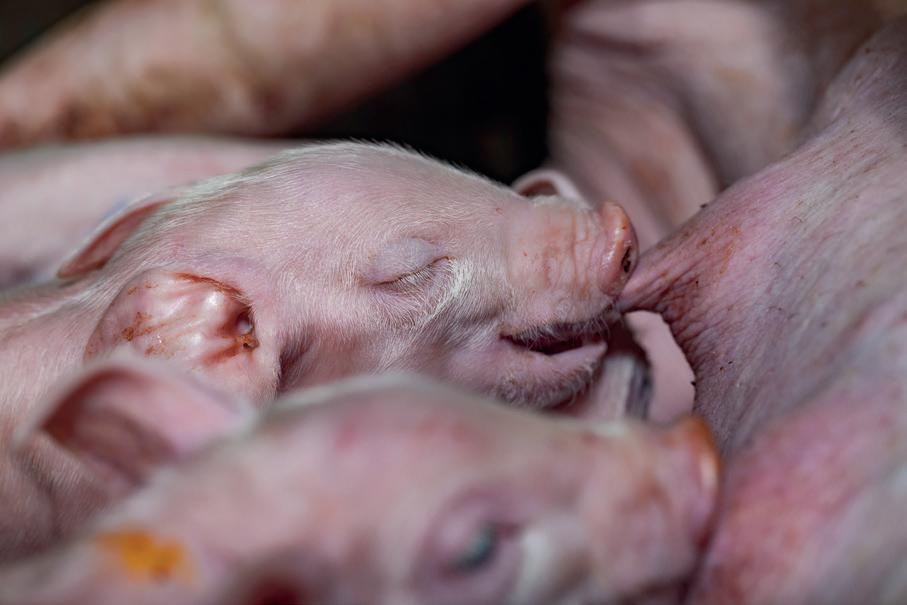
Ms Wilson says she is pleased with the pace Defra has worked to so far –and is keen that the policy remains a priority. Defra has also committed to
working with the industry on the next phase of policy development – fully engaging with the NPA.
“The bottom line is that, while legislative changes can set the framework for reform between the producer and whoever they have their contract with, real change must also come from within the supply chain.”
Ms Wilson says retailers have a key part to play and adds that the government alludes to the need for change with its commitment to share their findings with the Competition and Markets Authority.
“That will only change if pig farmers can see that retailers and processors have got the message that fundamental reform is needed if we are to secure supplies of high welfare, environmentally friendly assured Red Tractor British pork.”
help market reporting services better reflect the entire UK market – helping to further reduce ambiguity for everyone in the pig sector.

The National Pig Association welcomed the commitments, saying the government had addressed most of its key demands. But it said wider issues further up the supply chain – including the actions of retailers – must also be addressed.
NPA chairman and Norfolk pig producer Rob Mutimer said: “We are very pleased that Defra has taken on board the very clear messages from the NPA and the wider industry about what needs to be done to fix our broken supply chain.
“For too long, producers have been treated poorly and contracts have not been worth the paper they were written on – and we have seen some disastrous consequences of that behaviour over the past two years.
“We believe the measures set out today, including legal underpinning for contracts that delivers a fair transparent and negotiable contract system, will help deliver a fairer and more sustainable environment for pig producers.”
Defra insists it sees a bright future for British pig producers
The wet weather through March and April was about as helpful to drainage contractors and farmers as sandals are to Eskimo’s!!


Fortunately for us though we had some scrub to move, tracks to build and land to level in an area that was dry enough for us to get on with some work.
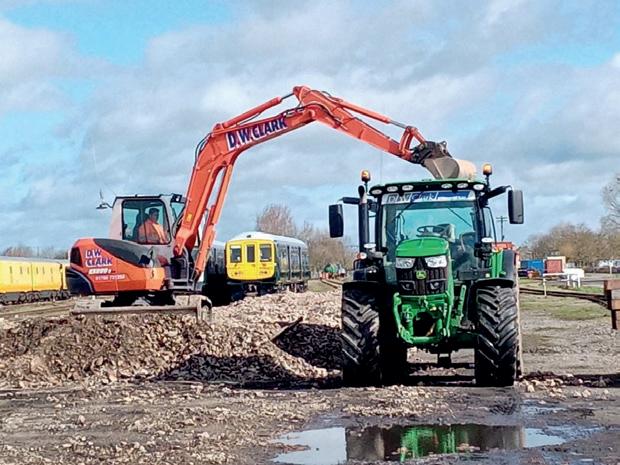
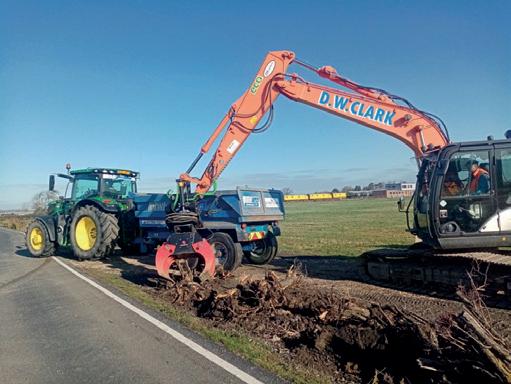
We were given “an idea” of what the client wanted then left to get on with it. A lot of work has gone into earning that much trust from the client.
All the materials for the tracks were sourced from the stockpile of crushed bricks, concrete slabs and concrete railway sleepers that we had produced when we demolished redundant Nissen huts and other

Once the roads were finished we were asked to remove some tree stumps that made the site look untidy. Being as we were there with our grab it was a simple job of pulling them out, carting them away to the tipping area ready for chipping and re-use as bark type covering around other parts of the site at a later date.

AHerefordshire farmer has been jailed for 12 months for destroying a stretch of the River Lugg – one of the country’s most unspoiled rivers.
John Price, 68, appeared at Kidderminster Magistrates Court last month where he was sentenced to 12 months in prison. He was also ordered to pay prosecution costs of £600,000 and disqualified from being a company director for three years.
The sentence is the result of legal action launched last year. It followed a joint investigation by Natural England and the Environment Agency into environmental harm caused by the work in 2020 and 2021.
Mr Price used heavy machinery –including bulldozers and excavators –to dredge and reprofile a 1.5km stretch of the River Lugg at Kingsland, Herefordshire. He claimed he undertook the work to improve the flow of water and reduce flood risk.
But the unconsented works breached several regulations, including the Farming Rules for Water; and operations prohibited in the notifica-
tion of a Site of Special Scientific Interest (SSSI). Prosecutors said Mr Price persisted with the work despite a stop notice.
Damage to the river and banks removed the habitats of hundreds of species – including otters, kingfishers and salmon as well as destroying trees, aquatic plant life and invertebrates.
Conservationists say it will take decades to re-establish mature trees to provide the stability, cover and shade to restore the diversity of the river. Fish, plants, native crayfish and birds may take years to make a gradual return to previous populations.
Speaking after the verdict, Natural England area manager Emma Johnson said: “The destruction of this section of the River Lugg was devastating for the abundance and range of species which thrived in this river.
“The River Lugg is one of the most iconic rivers in the UK and to see this wanton destruction take place was devastating. This is why we have used

our powers as regulators to see that justice was done and to act as a stark warning to others.”
Works to SSSIs or watercourses must be done in such a way that protects the environment and does not cause any impact on flooding. Such works can only be undertaken after securing permits from the Environment Agency.
Environment Agency place manager Martin Quine said restoring river health was a complex task which could only be achieved in partnership with landowners – most of whom fully cooperated with the process.
Mr Quine added: “We provide advice and guidance but will impose sanctions or prosecute where appropriate to protect the environment and ensure those who breach regulations are held to account.
“While Mr Price’s justification for the works was to help prevent flooding to local properties, his actions did not have any flood prevention benefit. The destruction of river banks is not appropriate flood management.
“We urge landowners never to take

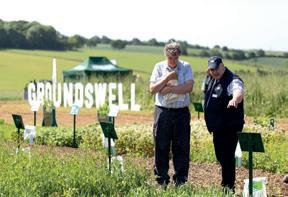


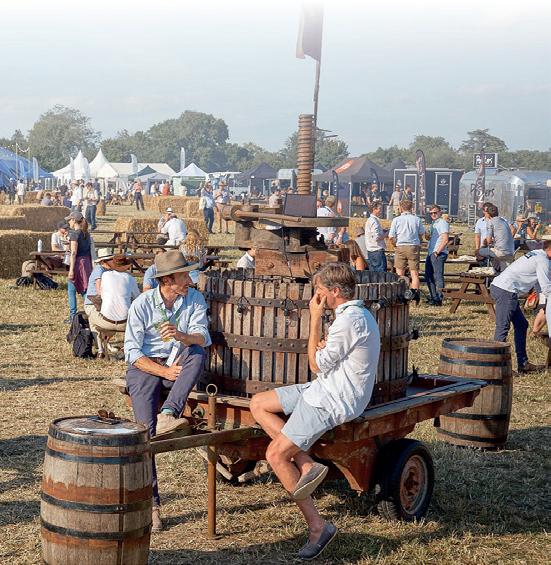
claimed he undertook the work to prevent flooding.

extreme measure such as this and instead to always work closely with the Environment Agency around river management to agree the best solutions for both landowners and the environment.”




The Arable Event – one of the largest farming events in the Midlands – is returning to the Shropshire-Staffordshire border this summer.
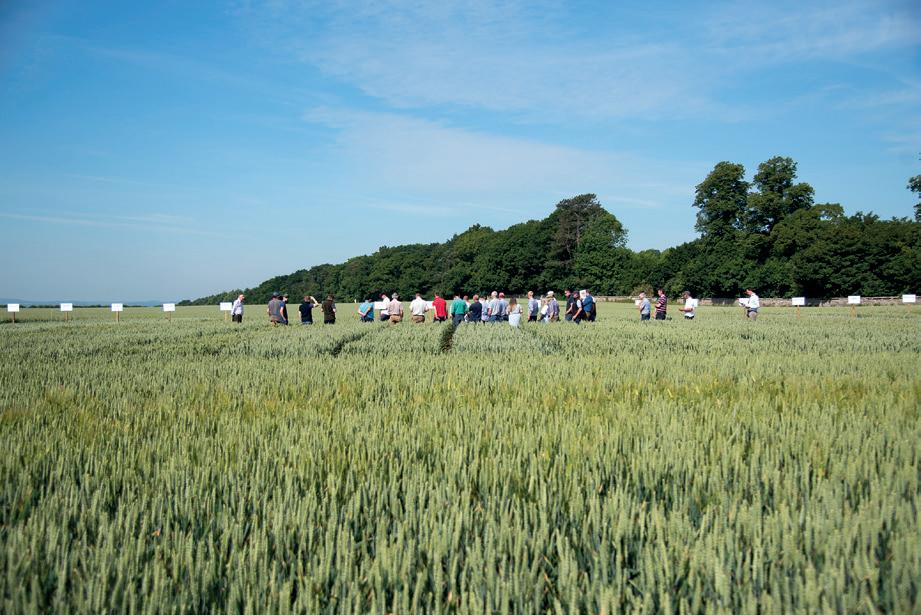
More than 1,500 people are expected to attend the one-day event. It is due to take place on 7 June at Woodlands Farm, which is part of Bradford Estates, outside Weston-under-Lizard, near Shifnal.
Organised by Wynnstay and GrainLink, the event will include exhibition stands, machinery demonstrations and extensive trial plantings. Trial plots will include winter and spring cereals and cover crops, said event organiser Kelly Dolphin.

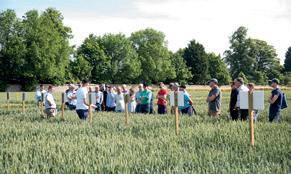
As well as trial plot tours and machinery demonstrations, the event will include a free moisture meter clinic run by Sinar Technology, an open air speakers tent and trade stands from a range of agricultural businesses.
“We have extensive cereal trial plots, expert speakers, the chance to see the latest machinery and the opportunity to collect BASIS and NroSO points. Every guest gets a free goody bag, refreshments and programme, so you won’t need to break the bank to attend.”
Woodlands Farm is operated by Bradford Farming. Their ambition is to establish the larg-

est regenerative farm in the West Midlands, with a vision to create a market leading agribusiness focused on sustainable farming systems.
The Arable Event is held on land that is mainly light sandy soils with a little body – a mixture of Grade 2 and 3 medium/heavy loams.
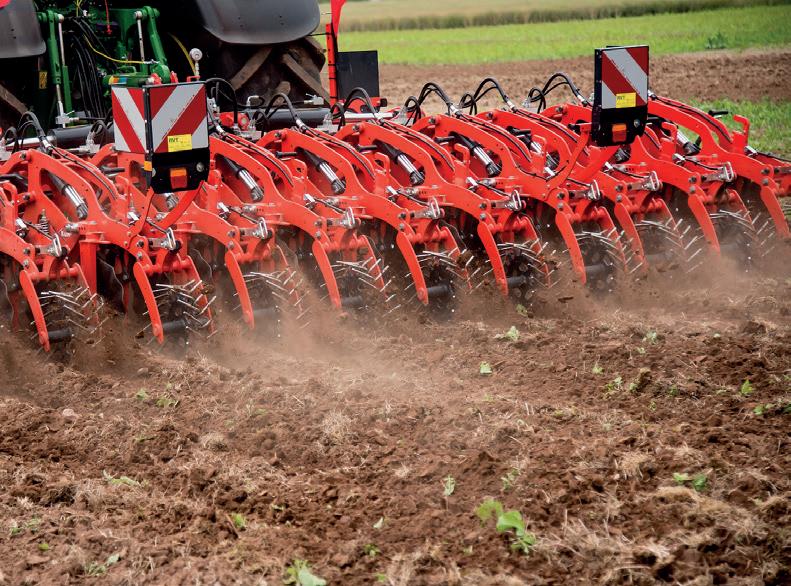
Entry is free but tickets should be pre-booked wherever possible. For full details about the event, visit www.thearableevent.co.uk.





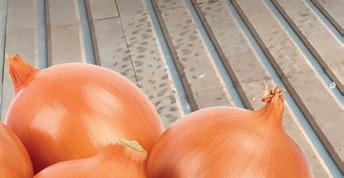




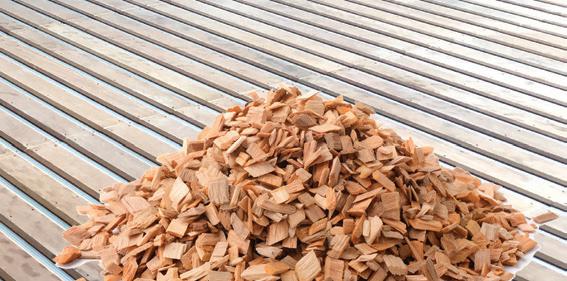
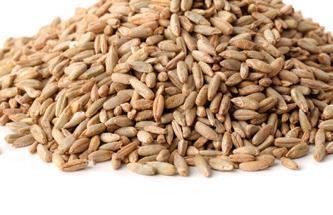
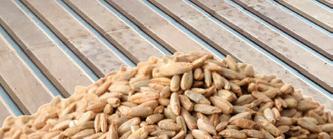
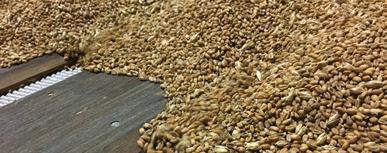


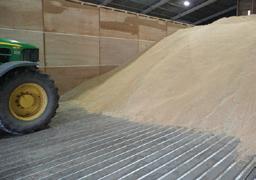

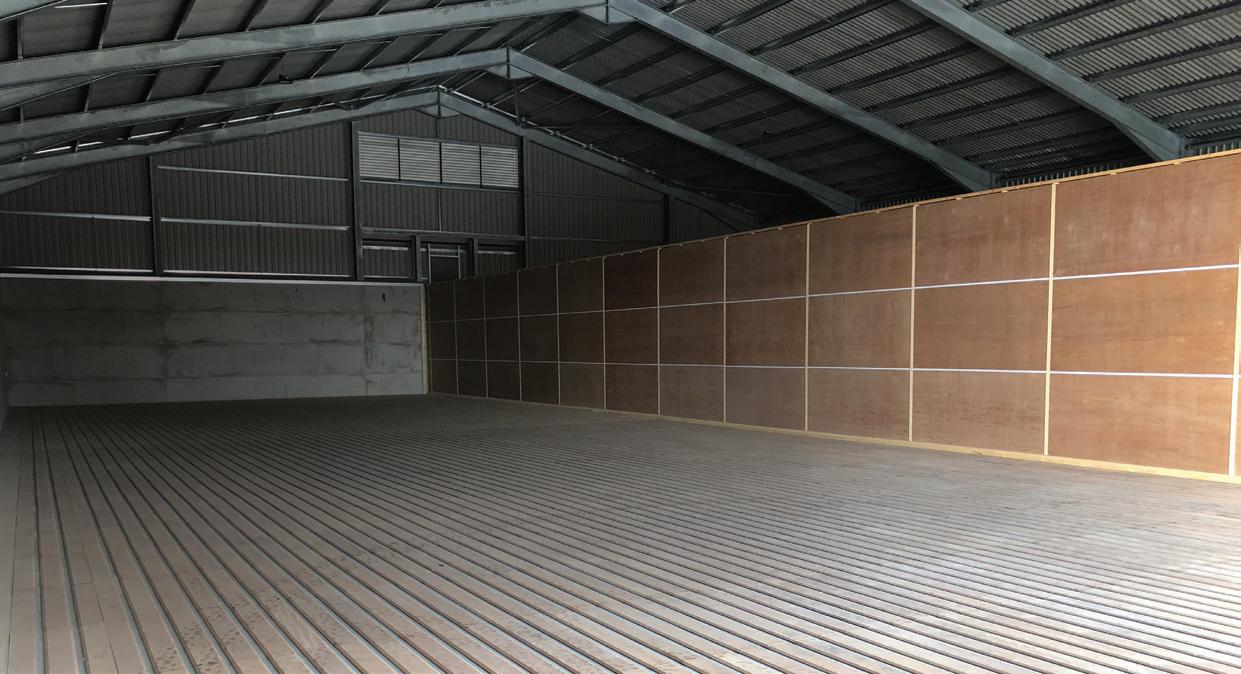
a rocky start, the Sustainable Farming Incentive (SFI) is looking more attractive – and with good reason, says
hen the government's Sustainable Farming Incentive (SFI) opened for applications, the response was distinctly un-
Reluctance to sign up was partly because the SFI compared unfavourably with the Basic Payment Scheme. There was also a deep-rooted suspicion of Defra’s ability to deliver something that was simple-to-understand and easy to
But the the past few months have seen more acceptance that the BPS is finally disappearing into history.
The money available under the SFI might be less than the BPS, but it can still make a meaningful contribution to a business.
Another reason take-up was initially low was because returns in some sectors were buoyant – even though costs had rocketed.
But the SFI can still bolster annual revenue by as much as £6,000 on a 120ha (250-acre) arable farm.
Farmers have always argued that fair and adequate commodity prices are preferable than a reliance on subsidies – and this may have switched the focus of some producers away from support payments.
A wheat price of, say, £250/t has meant a certain bullishness in the sector – prompting some farmers to believe the SFI isn't worthwhile. But such returns never last – which makes it prudent to take advantage of whatever is on offer.

The SFI is flexible and you don’t have to put all your land into it. Agreements last for three years, during which you can add more land or shift from ‘introductory’ to ‘intermediate’ levels – although you can’t downgrade in the other direction.
Charles MaysonThere is also an additional ‘management’ payment of £20/ha on the first 50ha of land, which could earn an extra £1,000. Payments are quarterly and begin as early as the first day of the month after your application, which will help with cashflow.
Any government policy will be a blunt instrument, so there will always be faults. But the broad direction of the SFI is laudable, with its focus on enhancing soils, reducing pollution and conserving nutrients.
The SFI is taking us in a direction where the nation’s farmers can produce food and look after the environment. We should be able to do both simultaneously. There are choices at an individual farm level, but overall it’s not a contest between the two.
Existing standards cover arable and horticultural soils, grassland soils and moorland. Six more will cover hedgerows, improved grassland, lowinput grassland, arable and horticultural land, integrated pest management, and nutrient management.
There is also the promise of fewer inspections. Rather than the overzealous threat of penalties, Defra says visits will be made by advisers whose brief is to help farmers deliver what they’ve signed up to.
We’re still in the honeymoon phase of SFI, so let’s hope these advisers do indeed prove to be collaborative. We certainly don’t want to go back to the bad old days when inspectors could lack empathy and be unduly harsh.
In this new post-BPS world, farmers will increasingly have to ‘mix and match’ revenues from different public and private sources. In doing so, the first consideration is whether the
Farmers can now choose from more management options
actions you want to take will fit your farming system.
Longer term, you can still make big changes to your strategic direction –such as committing to a big tree-planting scheme, entering the market for biodiversity net gain or going into renewable energy. Meanwhile, looking at the SFI makes sense.
We could have a new government next year and – with pressure on public spending – it is not impossible the SFI budget will get chopped. But my instinct is that it will survive for a few years roughly in its current form.
Some farmers still argue that it is better to wait and see what’s on offer next year or the year after before committing to the SFI. But there’s only one ball you can play and that's the one that’s coming towards you. Right now, that’s the SFI.
Charles Mayson is founder of agricultural advisers CXCS. For more details, call 01981 590514 or email info@cxcs.co.uk

The broad direction is laudable
“

Sunflowers offer UK farmers an untapped opportunity to supply a growing market this season –and avoid high input costs.
Suffolk seed merchant Grainseed reports significant interest in sunflowers due in part to Russia’s ongoing war against Ukraine. Both countries are major growers of the crop but production has fallen.
In a normal year, Russia would produce about 16.5m tonnes of sunflowers, with Ukraine accounting for 10m tonnes. But conflict between the two countries has limited both production and processing capabilities.
Demand could support 40,000ha of sunflowers in the UK – but so far only 300ha are currently grown here. “With climate change and increasing temperatures, the area will undoubtedly expand,” says Grainseed seed specialist Angus Fox.
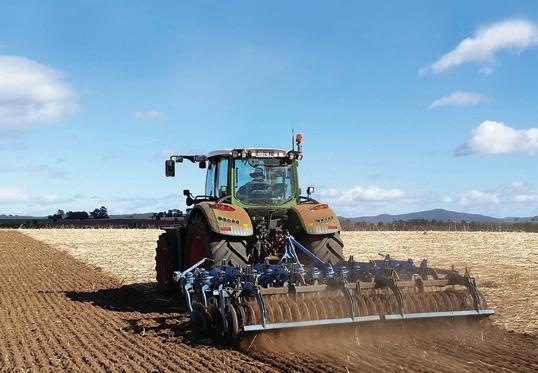
“Sunflowers can be successfully produced south of a line from the Wash to the Bristol Channel but now there are more favourable areas to the north and west which can be consid-
ered too,” explains Mr Fox.

The best-selling sunflower variety in Europe is Grainseed’s Es Bella – with more seed available for 2023. The crop typically yields about 2.3t/ ha in the EU but UK growers should expect to achieve about 1.6-3t/ha.
Even at this reduced level, the crop is profitable, says Mr Fox.


“With climate change we can produce good yields of good quality sunflower seed for the bird seed market. Of [all the] spring crops, sunflowers are an attractive crop for UK growers in terms of profitability.”

Bella is an early maturing sunflower variety with a high oil content of 48-50%. It has performed consistently well in trials and commercially in England, with good standing ability, disease resistance and high dry matter yield.
Nicholas Watts, of Vine House Farm in Lincolnshire, is one of the UK’s longest established sunflower growers. He planted his first crop in
1988 and grows about 40ha annually for bird seed sold to the public.
Mr Watts started growing sunflower seed to help improve wild bird populations. “As a farmer, I was able to do something about it,” he says. His advice is simply to “get the crop established – there are no short cuts.”
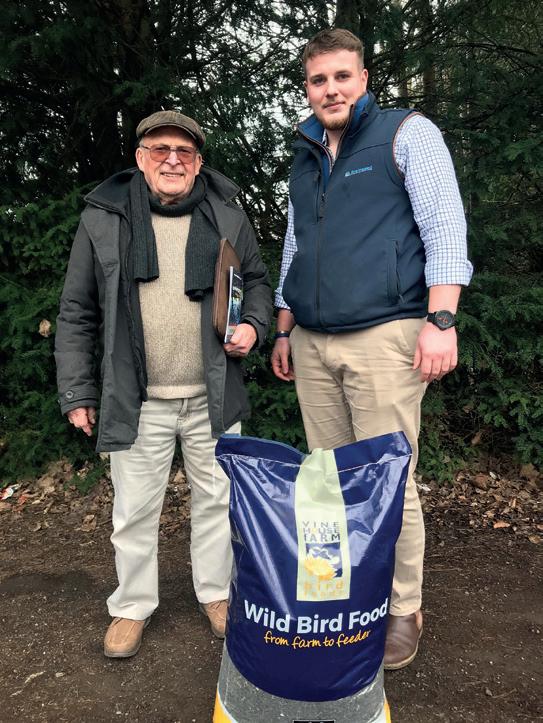
Agronomist and farmer Brian Fletcher has a wealth of experience of growing sunflowers and oilseed rape. “It is important to get the crop off well,” he says, and doing so will pay dividends at harvest.
“There are quite a few similarities between these two crops, but it is always attention to detail in all aspects of growing – particularly in establishment – that sets the tone for a good crop,” he explains.

New genetic resistances to two serious and costly diseases affecting oilseed rape could be available to growers in the next few years, say breeders DSV.

Breeder DSV says its Phoma Blocker trait – a new genetic mechanism for resistance to phoma stem canker in Europe – is already included in varieties going through UK testing, with enhanced clubroot resistance CRE1 close behind.

Phoma stem canker in rape costs UK growers some £100m annually in lost yields and disease management, says Simon Kröger, DSV’s leader for product management in oilseed crops.

“Resistance to phoma results in better and longer lasting plant health with better lodging resistance as well as a longer and undisturbed assimilation process that supports growth through tough climate conditions such as early summer drought.


“It also underpins optimum harvest date and can lead to higher yields as well as reducing the general level of phoma spores in the field.”
The main genetic disease resistance mechanism for many years has been RLM7, which is seen as an industry standard. But there is growing evidence it is becoming less effective.
In DSV trials in Dyngby in Denmark, for example, on a scale of 0-10 with 0 being excellent resistance and 10 being high susceptibility to Phoma, varieties without any qualitative resistance showed an average score of 7.5 with a range of 6.5 to 8.5.
Wider range
Varieties with the RLM7 gene showed a wider range of phoma susceptibility scores – from 4 to 9 – but of real concern is that the average was the same 7.5 as varieties with no disease resistance at all, says Mr Kröger.
“When you consider 53% of oilseed rape varieties on the 2023/24 AHDB
Recommended List for the UK rely on RLM7 as the mainstay of their protection against this yield-robbing disease, clearly this is a very worrying situation.”
RLMS provides some hope DSV Phoma Blocker adds a much-required


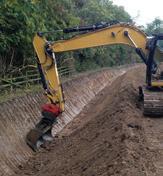
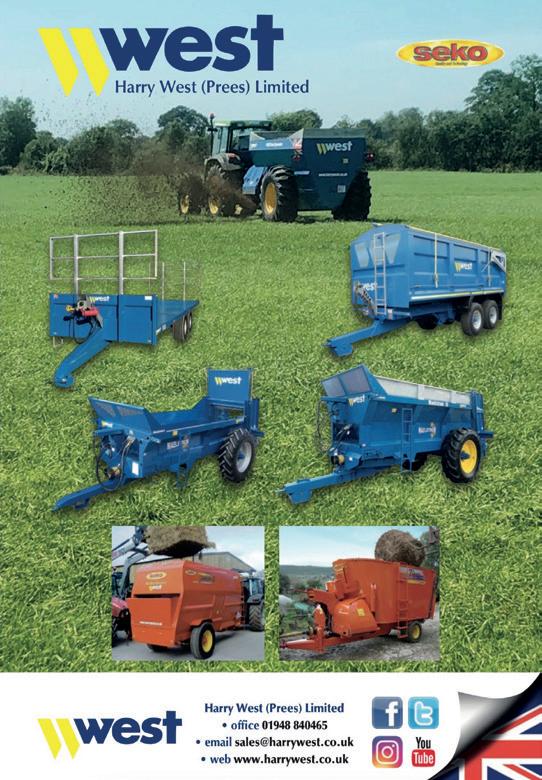


Continued overleaf
The main genetic resistance mechanism in rape has been RLM7
Left: Phoma stem canker costs growers £100m annually, says Simon Kröger

See us at Agri Expo -March 7th


-March 7th
NDUSTRIAL, AGRICULTURAL OR COMMERCIAL
AGRICULTURAL OR COMMERCIAL NTERNAL OR EXTERNAL

STRIAL, AGRICULTURAL OR COMMERCIAL TERNAL OR EXTERNAL

DIGESTION BASES
•STEEL FIXING
•STEEL FIXING
RUSH, TAMP OR POWER
USH, TAMP OR POWER
• APRONS & SHED FLOORS
ATO& TORES
• ANAEROBIC DIGESTION
TANK BASES
FLOATFINISHES
FLOATFINISHES
• GRAIN, POTATO & MACHINERY STORES
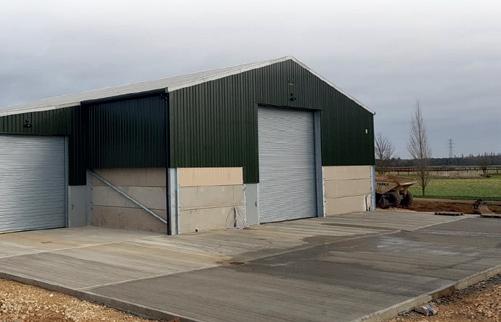
TIOS AND DRIVEWAYS
•FOUNDATIONS
•FOUNDATIONS
• PATHS, PATIOS, DRIVEWAYS
ROUNDWORKS & ARATION


• GROUNDWORKS & PREP
• POULTRYUNITS AND STABLE YARDS
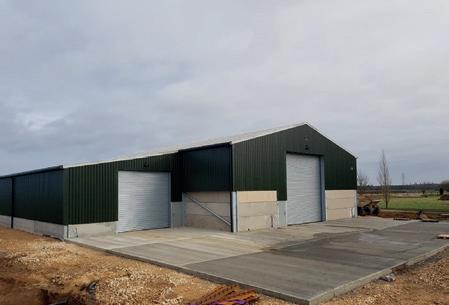

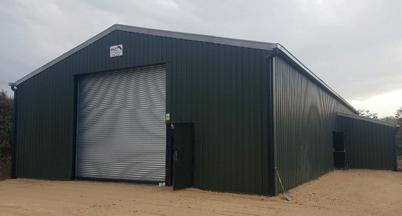
POULTRYUNITS AND STABLE YARDS
MATERIAL ADVICE AND COSTING
• sales@sjstanberry.com
MATERIAL ADVICE AND COSTING








•SILO BASES
•SILO BASES
PRONS &SHED FLOORS



RONS &SHED FLOORS
•ANAEROBIC DIGESTION





















NAEROBIC DIGESTION TANK BASES
TANK BASES







•GRAIN, POTATO& MACHINERYSTORES
•GRAIN, POTATO& MACHINERYSTORES
•PATHS, PATIOS AND DRIVEWAYS
•GROUNDWORKS & PREPARATION

Continued from previous page
extra layer of future-proofed security, believes Mr Kröger. “At the heart of Phoma Blocker is LepR1 – a completely new type of genetic mechanism for phoma resistance in Europe.
“While LepR1 by itself has been shown to have the best resistance to the most common phoma strains in field trials across Europe, we believe it is most effective when used in conjunction with other disease resistance traits.
“DSV Phoma Blocker is made up of LepR1 with RLM7 and this combination achieved an average of score of just 2.3 in the Dyngby trials – compared to the 7.5 for RLM7 by itself.”
But the real advantage is that DSV now has varieties featuring all three different phoma resistance mechanisms: RLM7, RLMS and LepR1. These can be rotated in the field to minimise major breakdown of any one type of resistance, adds Mr Kröger.
This has taken phoma resistance in rape several stages on, he adds. DSV already has Phoma Blocker varieties moving through the UK testing process, with the first of these set to be commercially available in 2024.
New genetics to improve resistance against the growing threat of clubroot are also being introduced by DSV, says managing director Alex Doering.

Caused by the pathogen Plasmodiophora brassicae, clubroot is a highly infectious, yield-robbing disease. Scotland has experienced heavy infestation in recent years, but there is growing evidence of clubroot problems in south-east England.
In recent years, hybrid oilseed rapes with genetic clubroot protection have played an important role in keeping spread of the disease in check and also protecting yields for growers, says Mr Doering.
DSV has been particularly successful in this area. Varieties such as DSV Crossfit CR and DSV Crocodile CR offer good protection without sacrificing yield, as has usually been the case before such varieties were introduced.
DSV is introducing a new clubroot resistance mechanism called CRE1 with broader protection against more pathotypes.
The first DSV CRE1 variety is expected to
be EU-registered during winter 2023/24 –arriving in the UK a few years later.

We’ll also be demonstrating at the Arable Event - June 7th


An autonomous, entirely self-sufficient, carbon-neutral, solarpowered battery-operated field robot controlled by precise GPS, undertaking both sowing & weeding in and between rows.

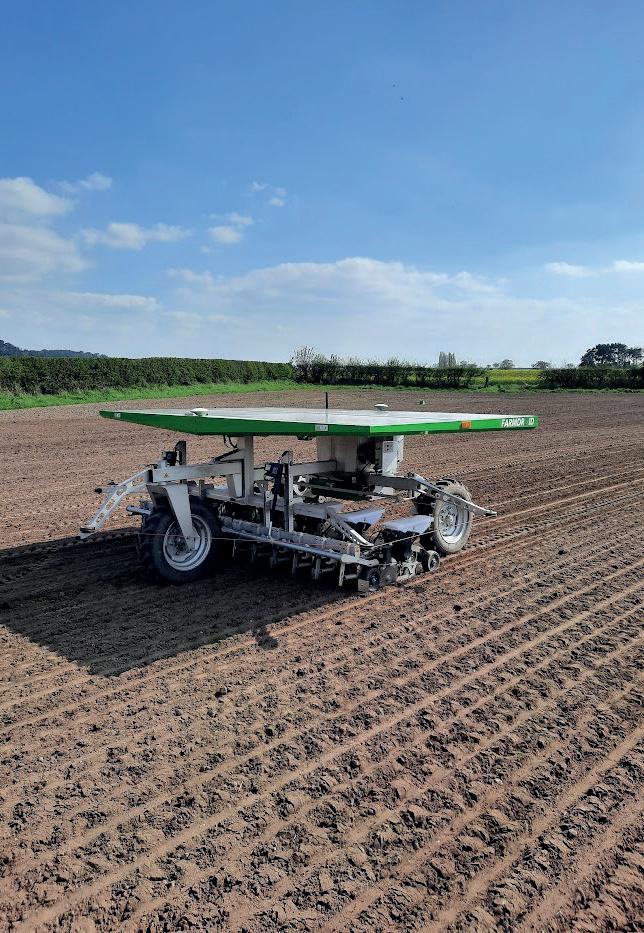
Agri-Droid is the official distributor of the FarmDroid FD20 in the counties of Shropshire, Staffordshire, West Midlands, Worcestershire, Herefordshire, Powys, Clwyd and Cheshire.
Smethcote Manor, Hadnall, Shrewsbury, Shropshire, SY4 3DQ
INDEPENDENT
Located within 3 miles of junctions on the M1, M6, M69 and A14.
Located within 3 miles of junctions on the M1,M6, M69 and A14.












We can offer individual storage Drying and cleaning facilities. Handling of infested loads as well as rolling cereals and pulses on site.


We can offer individual storage. Drying and cleaning facilities. Handling of infested loads as well as rolling cereals and pulses on site.

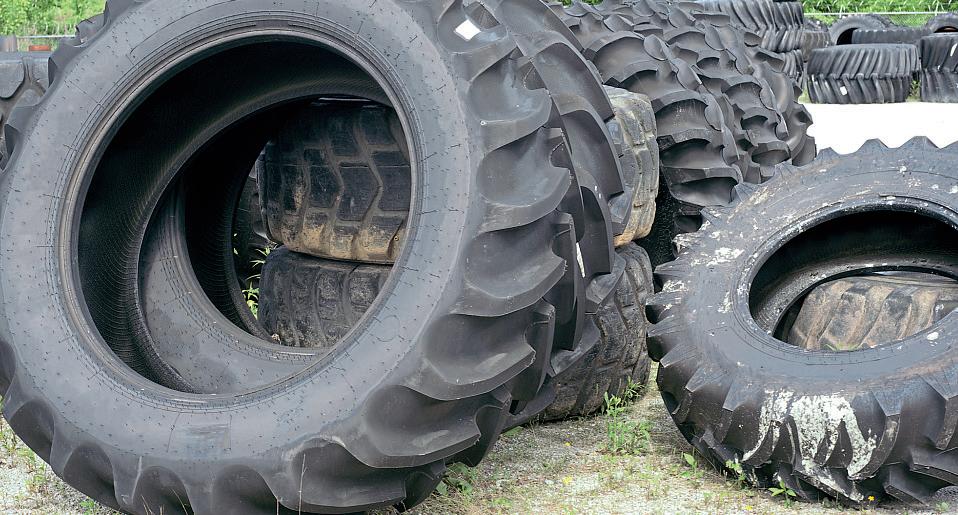


Agents fo DICKEYjohn moisture meters







Agents for DICKEYjohn moisture meters



























The DICKEYjohn Mini GAC 2500
The DICKEYjohn Mini GAC 2500
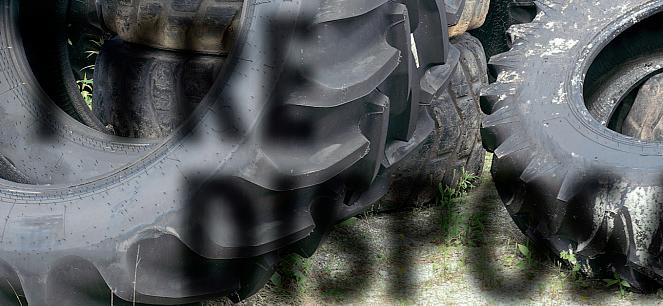
The Mini GAC 2500 hand-held has proved to be the UK’s most accurate moisture meter. Consistently proving its accuracy and reliability using the lasest 149MHz technology and is cheaper than similar UK models.
The Mini GAC 2500 hand-held has proved to be the UK’s most accurate moisture meter. Consistently proving its accuracy and reliability using the lasest 149MHz technology and is cheaper than similar UK models.
Amajor UK survey has confirmed significant variability in crop nutrients and soil quality – making it harder to grow crops cost-effectively.
UK soil has far greater variability in its structure, nutrient make-up and ability to utilise nitrogen than previously thought, according to the fiveyear study of almost 50,000 individual fields carried out by NRM.
The finding means farmers striving to boost productivity against a backdrop of greater environmental and sustainability demands are doing so with sub-optimal resources, says NRM analyst Sajjad Awan.
“It’s been a real eye opener just how variable our soils are. Some of this is undoubtedly being driven by climate change with the wetter, milder winters and drier, hotter summers now experienced affecting soil microflora and biology significantly.
The study findings suggest a need to reshape some aspects of farm management, says Dr Awan.
Although this might sound daunting, some simple steps can address many of issues, he adds.
Carbon content is a good guide to the overall organic matter of soils. Although carbon levels are low on many arable farms, they can be improved –and there are many beneficial aspects of doing so, says Dr Awan.

“Generally speaking, we’re seeing arable land containing 24% less soil carbon than that used for livestock, but within all soils there is tremendous variation in this.”
In arable soils, for example, NRM CarbonCheck shows the range is from 28t/ha to 178t/ha for total carbon stock measured at 30cm with the median being 86t/ha. For livestock this is about 113t/ha which is close to that of horticultural soils at 122t/ha.
“If you’re growing crops on land in the lower range of that scale, you will be struggling. Soil carbon content affects all manner of things including moisture retention, overall soil health and nitrogen use efficiency.
“Using Farmyard manure (FYM) and other organic materials can help–and so can reducing the number of cul tivations, disturbing the soil less and avoiding soil compaction.”
While producers increasingly realise the importance of soil testing ahead of fertiliser applications, few appre ciate the significance of testing nutri ent offtake values in the grain postharvest, says Dr Awan.
“Knowing how much nitrogen, pho shape and potash is contained with in the grain can give you a vital early indication of fertiliser needs for the following season. Again, our analysis shows this varies considerably from year to year.”
The extent of these changes is high ly significant, says Dr Awan. Grain nitrogen offtake measured using NRM GrainCheck at harvest 2022 was around 4% lower than in 2021.
“At a time when nitrogen prices are so high, understanding precisely what nitrogen is in the soil in the shape of soil mineral nitrogen (SMN) and the total soil nitrogen supply (SNS) can help save on fertiliser bills.”
Drier summers are also creating a greater number of soils with indices below 2 for phosphate and potash. Where summer droughts were experienced, there were 13% more soils below index 2 in the drier years than in an average year.
“Mineralisation of phosphorus in the soil is much reduced under drought like conditions and this is reflected in our analysis with the distribution curve visually skewed towards the lower indices.
“Increasing soil organic matter helps soils retain moisture better and hold key nutrients more effectively whilst building vital resilience to future droughts.
“Minimising ploughing and disturbance of the soil will help get the biology working to its full potential as will the use of FYM and other organic sources of nutrition.”
slurry to farming systems is much more variable than previously thought with some applications contributing just 3% of that from others.
“The differences are of a magnitude I don’t think anybody was expecting.
Focusing on N, P and K alone shows a 20t/ha application ranges from £100 to £3300 in terms of nutrient value.
“It’s another great example of how working with average values and making management decisions based on these can be so damaging to production and profitability.”
Analysis shows that a quarter of UK arable land is below index 2 for magnesium. This means many growers are trying to maximise production with a hugely important nutrient exerting severe limitations on this.
“Magnesium is essential in the production of the chlorophyll that drives photosynthesis, enzymatic activation and protein synthesis. It’s as least as important as phosphate and potash yet all too often gets overlooked.
“A greater emphasis on individual testing, whether it be soil organic matter, soil nutrient status, nitrogen offtake in harvested crops or for a whole host of other analytics, has got to become a routine part of future farm management.”
Better testing must become routine
“
Soil nutrient content is extremely variable, says NRM analyst Sajjad Awan.
Mark Weatherhead Ltd


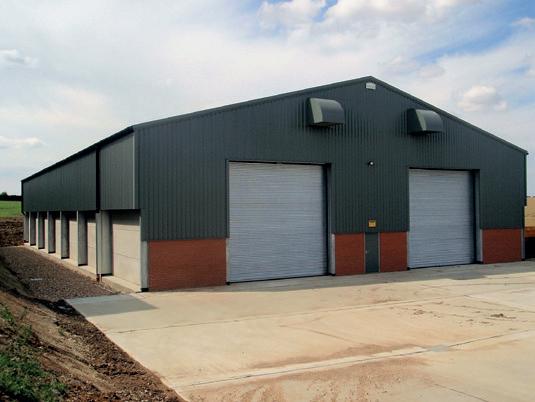


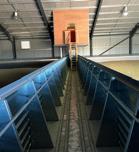
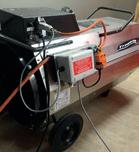

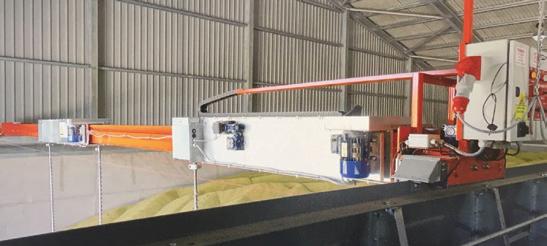
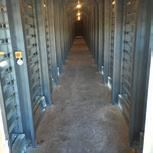








Telephone: 01954 210 355


Mobile: 07885 202 005

Hardwick, Cambs CB23 7QL

Grange Machinery heads to the Cereals Event in the midst of an exciting year for the family-run company based in Holderness, East Yorkshire, with expanded distribution and a major new product line.
The company manufactures agricultural machines and wearing parts that offer affordable solutions to farmers across the UK, Europe and as far afield as New Zealand.
The Grange Machinery product range helps lower the cost of crop establishment whilst improving soil structure and efficiency in the field, using technology based on the family’s own farming experience. It specialises in adaptable low disturbance toolbars and standalone looseners which offer solutions to many cultivation and seeding challenges.
Grange Machinery has seen rapid expansion of its dealer network this year, signing up leading businesses Peacock and Binnington to cover North Lincolnshire and East Yorkshire, and MANNS with branches in East Anglia, Kent and Leicestershire.
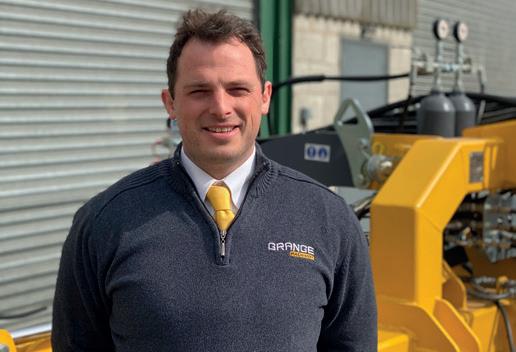
Midlands dealership B&B Tractors is the latest to join the network. Established in 1991, B&B Tractors has four depots covering Nottinghamshire, South Yorkshire, Derbyshire, Staffordshire, Warwickshire and Leicestershire.


“We are very pleased to have B&B Tractors on board. We feel the product range we offer will enhance and compliment the current B&B product portfolio perfectly. They are a progressive dealer offering high quality products with a vision of where farming practises are moving to. We’re looking forward to working with them and growing the brand in their area,” commented Rhun Jones, Grange Machinery managing director.
Grange Machinery has added an important new product line this year, aimed at helping farmers reap the benefits of strip-till cultivations.
Designed with input from farmers looking for the perfect tool to help establish their maize, sugar beet or brassica crops, the Strip-Till Preparator has been developed over several seasons.
“We designed and built three prototype machines which had various changes and additions to the frame and the general layout in the row to achieve a truly effective and versatile implement,” explains Rhun Jones. “It’s essential to get the design of this type of machine exactly right to make the perfect strip to allow targeted planting and application of fertiliser, making the best use of costly inputs, preserving moisture and improving soil quality.”
Three independent rows of cultivation discs can be hydraulically adjusted whilst working in harmony with a low disturbance tine and point, a unique feature which allows the Preparator to create a perfectly cultivated row that is ready for planting.

A zonal Guttler prism roller ring performs the final part of the cultivation pass to break down any clods that have flowed through the system as well as consolidating the row in readiness for a planter.
Another unique feature that the Preparator offers is the option of applying either granular or liquid fertiliser behind the loosening tine.
Leg spacings can be specified at different row centres to suit a range of sowing systems and crops. Hydraulic front cutting discs are fitted for trash management and to provide minimal disturbance.
Available in 3m, 4m and 6m working widths; horsepower requirement is from 210hp.
The Strip-Till Preparator is now in full production and can be seen working this season.
Meet Grange Machinery on stand 651 at Cereals to find out how this innovative range of equipment can boost margins on your farm.
Colin Blood, sales manager at B&B Tractors added: “We’re thrilled to be working with Grange Machinery and feel that the addition of a deep cultivating range will be highly valuable to our offering. As some of our branches are in mixed farming areas, the grassland aerator will be well received and we are also looking forward to offering products such as the low disturbance subsoiler for customers moving into regenerative agriculture.”
B&B Tractors will also be exhibiting at Cereals, showing examples from the Grange product range.
For more information contact: Oliver Beekes Tel: 07387 824748
obeekes@grangemachinery.co.uk
www.grangemachinery.co.uk
 Grange Machinery managing director Rhun Jones
The Strip-Till Preparator is designed to create a perfectly cultivated row to establish maize, sugar beet and brassicas
Grange Machinery managing director Rhun Jones
The Strip-Till Preparator is designed to create a perfectly cultivated row to establish maize, sugar beet and brassicas
Next month’s flagship Cereals event is set to host nearly 400 exhibitors and sponsors – including companies keen to attend the show at its new location.
The two-day event on 13-14 June is being held for the first time at the Thoresby Estate in Nottinghamshire. Attractions include companies exhibiting for the first time too – and those returning after a break.
The show continues to be the leading technical event for the UK arable industry, with live demonstrations and areas dedicated to agronomy, technology, machinery, business, education, environment and renewable energy.
Suppliers big and small will showcase their latest products, advice and information – providing visitors with a one-stop service from seeds to sprayers, crop varieties to cultivation equipment, and fertiliser to finance.
Event organisers say the range of exhibitors means visitors looking for the latest machinery will be able to choose from plenty of stands and demonstrations – including min-till drills, spreaders, harvesting and baling kit.

Centre stage on the John Deere stand will be the HarvestLab 3000 system –now available on S-Series and T-Series combine harvesters. It uses near-infrared sensors to measure the quality of wheat, barley and oilseed rape as it is harvested.
“Up-to-the-second analysis delivers numerous benefits,” says John Deere tactical marketing manager Chris Wiltshire. The technology gives farmers a continuous view of field performance –informing input decisions for the season ahead.
“These include being able to know for certain whether wheat has met milling quality specifications, the
The two-day event will showcase products from 400 exhibitors
grain quality at an individual point of a field, and gaining an overall picture of which soils have converted nutrients into yield and protein.”
tion, allowing visitors to get up close and personal with 550hp+ tractors and 12m cultivators, reaching speeds of over 20kph.”
Suppliers will showcase their latest products
Cultivation and controlled traffic farming specialist Bednar will be exhibiting at Cereals for the first time. It will be working closely with UK marketing partner Case IH, with a selection of high horsepower machines on display.
“This will help farmers and their operators to understand the future of cultivations – efficiency while minimising labour inputs,” explains Bednar UK managing director Warren Rivers-Scott.
“During the event, we will also host an exciting arrive-and-ride demonstra-
Where: Thoresby Estate, Perlethorpe, Newark,NG22 9EQ. Once near the event, turn off sat-nav and follow Cereals Visitor or Exhibitor Parking signs.
When: 13-14 June 2023
New for 2023
• Biomass demonstrations and seminars to get a working view of your renewable energy options
• Bednar working demonstrations in partnership with Case IH
Eyre Trailers returns after a fouryear break. It will exhibit a new trailer for draper headers.The company manufactures header trailers as an independent supplier for New Holland, Case IH, John Deere, Agco, Deutz and MacDon.
“The marketplace has changed significantly from a rigid header to bigger combines using draper headers,” says Eyre managing director Bob Eyre.
“Many trailers are made abroad but we are geared up to make them in the UK and interest is growing. We have come to Cereals to re-establish ourselves in this market. We are also developing a patented harvesting technique but that is for future shows.”
Working demos
• More than 200 machinery demonstrations
• Sold-out Syngenta Sprays & Sprayers Arena
• Sold-out Drill Area
• Mechanical weeding demos presented by Garford
• Working demo plots presented by Bednar, Case IH, Hardi & New Holland
• Robotics & automation demos presented by Agxeed
For tickets and full details, visit www.cerealsevent.co.uk

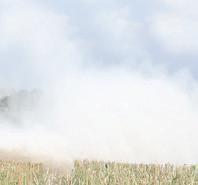




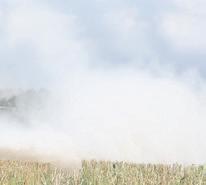



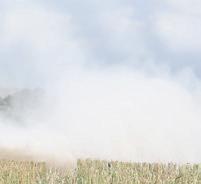
















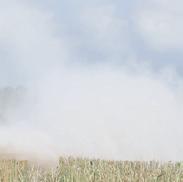






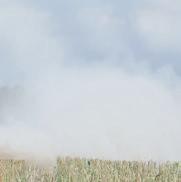



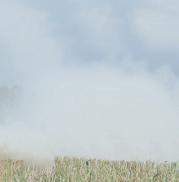











































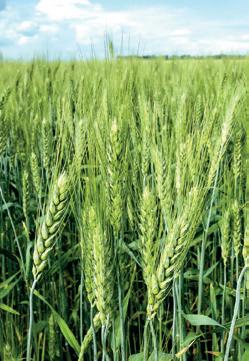








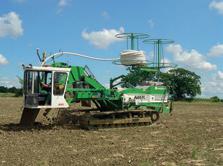



















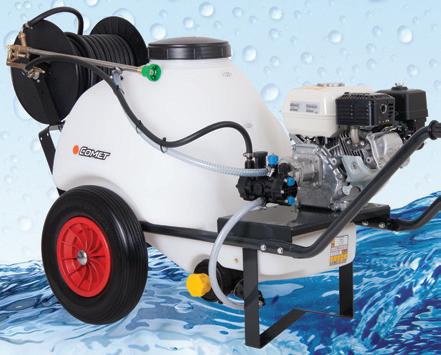
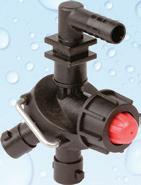



Cereals has a wealth of seminars this year – with opportunities to question politicians, environmental service providers and growers who have decided to adopt regenerative farming methods.
The main stage starts with a session looking at privately funded environment incentives, with presentations on ecosystem services that provide farmers with new income to deliver greater biodiversity, protect wildlife species or curb pollution.
Accurate and statistically robust soil carbon measurement is fundamental to the success of everyone who is
Ms Leeson will lead a seminar explaining the methods needed to implement affordable, auditable, and statistically robust on-farm carbon measurement strategies at scale.
“We need to remove uncertainty in all stages of the process, from sampling strategy to sample collection, processing and analysis. Our mission is to provide confidence in soil carbon sequestration by providing a solid foundation of evidence from the field.”
Farmers also have an opportunity to quiz politicians and industry leaders – including Defra farm minister Mark Spencer and NFU president Minette Batters – on issues ranging from food security to trade deals.
These sessions are likely to cover grant schemes, new arable and farm
shape opportunities and forge a better future for British growers.
Farming speakers will provide new insights and practical experience of the benefits of circular and regenerative farming methods. A seminar on ‘great soils, great crops’ will see soil scientists discuss their research.
Keynote speaker and LEAF farmer John Renner will explain how he has improved his low-grade land to such an extent that it is now part of a highyielding arable rotation.
“I tailor soil management and fertility to individual fields and rotations,” he says.
“Non-inversion tillage, added organic matter and crop selection to enhance soil structure are key.”
A further session on publicly funded environmental incentives will be led by Defra future farming programme director Janet Hughes. She will provide an update on the government’s land management schemes to encourage greater on-farm biodiversity, landscape and wildlife protection.
New technology and climate change will also be key topics. A new feature for 2023 will looki at ways precision farming can pay for itself. It will explore best practice in precision farming with progressive farmers, advisers, and precision technologists.
The first session will looks at ‘mustsee machines to help you farm more precisely’, including nitrogen sensors, spray nozzles, protein monitors and variable seed rate drills.
Thousands of visitors are expected to attend this year's event
Now in its third year, the Land Drainage Hub – organised by the National Association of Agricultural Contractors – has proved a popular attraction at the Cereals event.
Topics this year include an overview of UK drainage. This willexamine the ongoing importance of drainage in ensuring good soil structure and farm productivitty.
A further topic will look at ways to make land drainage work in minimum tillage systems.
With the farming industry going through an unprecedented time of change, Cereals organiser Alli McEntyre says visitors to the event will find something for everyone in the seminar programme.
“We have gathered together the most knowledgeable in their field, including politicians, experts and farmers to give Cereals visitors a head-start in meeting today’s and tomorrow’s challenges.”
Speakers will include AgAnalyst precision technologist Clive Blacker, BBLeap founder and precision spray expert Peter Millenaar and Yara head of agronomy and business development Mark Tucker.
At the new Cereals Stories stage, first-time farmers will tell their stories about how they got into the industry – and what they have contributed and continue to give back.
Speakers include Cereals host farmer Gregor Pierrepont, discussing his family connection to the Multiple System Atrophy Trust; farm contractor and influencer Olly Harrison; and NFU student and Young Farmers' ambassador Erin McNaught.
For full seminar programme details, visit www.cerealsevent.co.uk
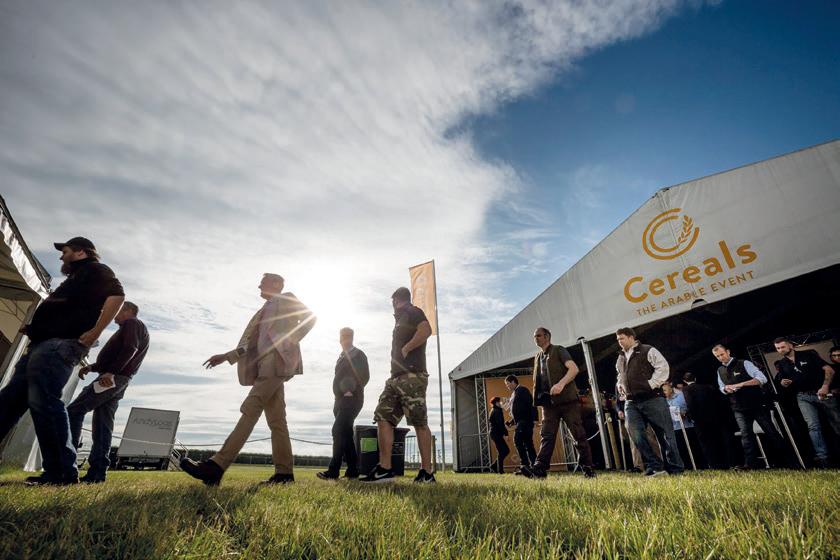
The goal is to forge a better future
ers advice and grant support at this year’s Cereals event.
Face-to-face advice is increasingly important when it comes to ensuring farmers are best placed to deliver environmental benefits, says CSF ad-
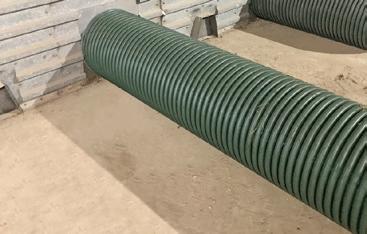
viser Mark Taylor.
“It’s a great way of meeting farmers,” Mr Taylor explains. “Previously we worked with farmers in high priority areas. But now every farmer is in a catchment of one sort or another – right across the country.”
A CSF crop plot at the Cereals event
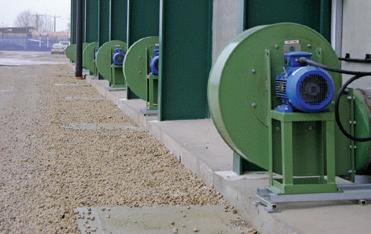

will showcase different conservation mixes – including wild bird mixes and pollen and nectar. The aim is to highlight the benefits of signing up to Countryside Stewardship, says Mr Taylor.
“Farmers will be able to come along, see what the mixes look like and get advice on how to grow them. The Defra team will be on hand to talk about the Sustainable Farming Incentive and other environmental schemes too.”
Other plots looking at soil structure and soil health. “We hope to have a living mulch crop with an understorey companion crop to the cash crop which can to help reduce inputs such as pesticides, fertilisers.”
These plots will highlight how root systems developed by companion crops can help improve soil structure and soil health, explains Mr Taylor.
A maize plot will demonstrate the importance of crop establishment, including the practicalities and timing of under-sowing maize and how it can be managed and supported throuygh countryside strewardship.
“By doing that, farmers can reduce soil erosion and water pollution – and improve water quality. It gives the harvesting machinery something to travel on, and it’s going to provide that green cover over winter.
“Green cover rather than bare maize stumble can reduce soil erosion, improving soil health and water quality. “When it grows on and dries up a bit, it could also offer an additional income through grazing or a cut of silage,” says Mr Taylor.
A number of added-value specialist crops will be showcased at Cereals – including spelt wheat, canary seed and linseed.
Alternative crops targeting specialist markets can generate a valuable additional source of farm income – so long as they meet specification, says Nigel Padbury, of seed suppliers Premium Crops.
Crops will include staple added-value crops like winter and spring linseed, including a high omega-3 variety, high erucic acid oilseed rape varieties and some spring sown options, high
protein wheats, naked oats and canary seed.
A spelt wheat crop plot will highlight a special contract for growers. Also special will be two cover crop mixtures – one sown as a precursor to a spring linseed crop and the other as a precursor to a canary seed crop.
“We will be showing how you can produce a cover crop that will give you a good entry into what is really quite a small seeded spring crop. It will do all the things you want from a cover crop, while providing a good seedbed for a small seeded crop afterwards.”
Seed breeder LSPB has increased its presence at Cereals as it returns to the event to highlight some new varieties at the event.
Crop plots will include varieties which have gone through national list trials, said the company’s Michael Shuldham. The main focus will be on oilseed rape although the LSPB will also showcase some pulses, including spring bean Lynx.
“It’s a variety really favoured by end-market users,” said Mr Shuldham. High-yielding

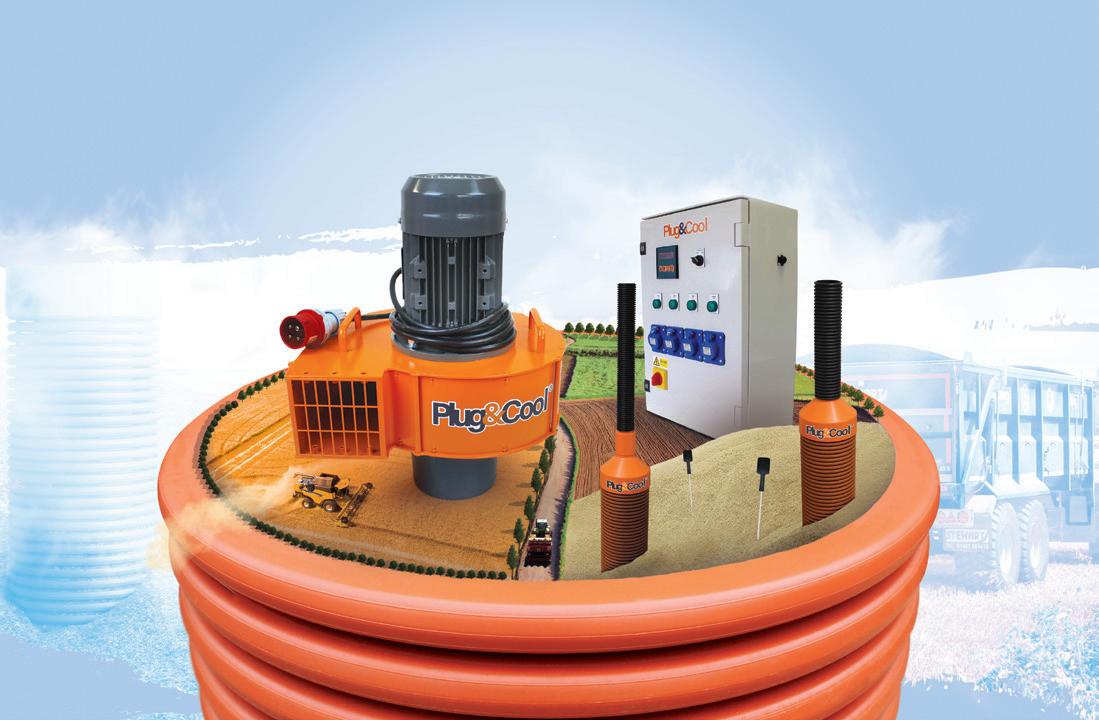
green pea variety Carrington – on the 2023 PGRO Descriptive List for combining peas –will also be showcased, he added.
The crop plots look good, despite the wet spring and a cold snap during April. The oilseed rape has established well – a testament to the vigour of LSPB varieties, said Mr Shuldham.
“Everything has come up really nicely,” he added. Hopefully when we get to June time, we’ll really be able to see our stay-green stems – we’ve some top yielding varieties.”
Mammoth Millet - the perfect solution for failed crops of rape.
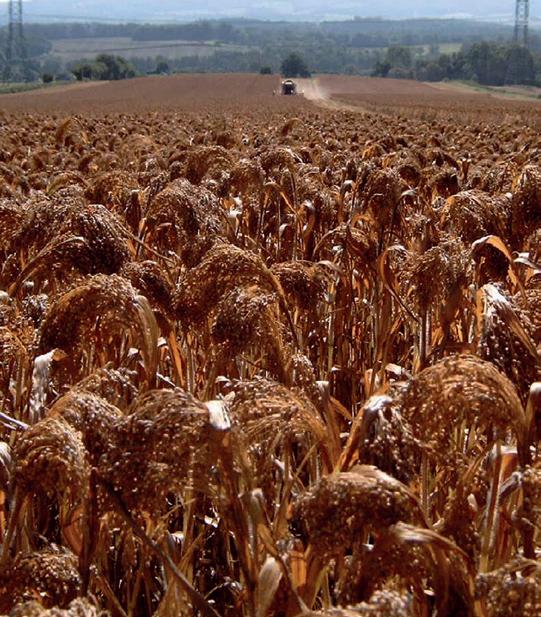
OSR Growers know the frustration and difficulty of realising late in the spring, that a crop of OSR isn’t going to be viable. This creates the dilemma of what to do - especially if the ground has been sprayed with autumn herbicides.


Mammoth Millet is not sown until early May, and can be direct drilled or sown after failed rape with minimal cultivations. Furthermore, the Millet now arguably offers as good or better a gross margin than OSR anyway - thus putting things back on track.
Mammoth is a cheap,- simple and easy crop to grow and we are seeking new growers for 2023.

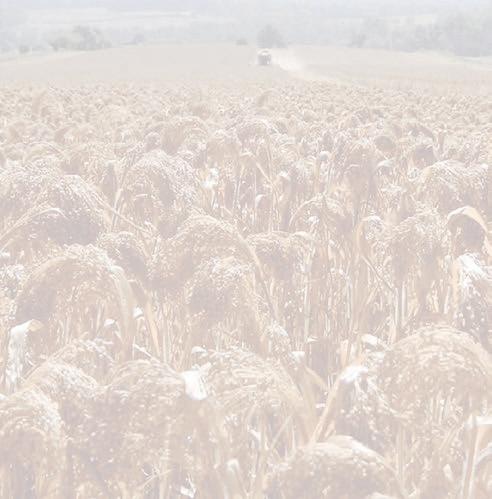
Why
•Quality agri seats for the OEM and aftermarket









•Leading suppliers include Grammer, KAB, United Seats, Sears and Isri

•Retrims, parts and spares
t:
e: sales@tekseating.co.uk | www.tekseating.co.uk

Afarming family who suffered a fire in their grain dryer had it redesigned and safely installed for the following harvest.
WF Wells & Sons is a five-brother partnership and the third generation to farm at Camerton, near Bath, Somerset. The brothers grow winter wheat and barley, spring barley, spring beans, oilseed rape and maize to feed their dairy and beef herd.
“The dryer caught fire in 2021 as a result of an accumulation of dust,” says Andrew Wells.
Expert view
“Dry weather meant the crop was particularly dusty and dirty and the location of the dryer – which was installed in a tight space – meant it was dragging in air laden with dust which was settling on the burner tubes.
After the fire, Mr Wells called Andrew Head, sales director for grain drying experts BDC Systems. He confirmed the cause of the fire, which aligned with the view of the insurers.
Mr Head also worked out how to extract the grain from the fire-damaged dryer – instructing Mr Wells to call a demolition team.
“We did and they were brilliant, dismantling the dryer without damaging the shed itself, leaving the way clear for the new installation.”
Fire risk
Despite the new dryer having to fit within the same tight space as the destroyed dryer – and having to protrude through the roof of the grain shed, Mr Head worked closely with Mr Wells to re-design the plant and greatly reduce the fire risk.

Following discussions with insurers around the need to provide best value for money, Mr Head safely installed a Svegma 37tph continuous flow dryer with a 4m footprint into the available space.
The design of the new plant enabled the Svegma to be rotated 180 degrees enabling dust-free fresh air to be
drawn into the drier’s furnaces – future-proofing the plant which includes the latest grain handling equipment.
Gravity discharge
Grain from the field is now tipped into a large gravity discharge intake bunker. A belt and bucket elevator then drops through an Aagaard heavy duty aspiration pre-cleaner to remove light dust and chaff.

Grain is then transported via a Skandia SEI35/14, 60tph elevator which feeds a Skandia KTIFFR20/33, 60tph flow and return conveyor to the Svegma dryer. Once full, the surplus grain from the dryer flows back by gravity to the intake bunker.
The Svegma is fitted with vertical
turboclean dust extraction fans and dust extracted is pneumatically conveyed to the dust box by a Kongskilde TLR blower, rather than remaining airborne around the furnaces.
The dryer is discharged through a Skandia KTIFb20/33, 60tph chain and flight conveyor with grain transported through a reciprocating cleaner or direct to store using the existing handling system.
Mr Wells also chose to deploy BDC’s moisture monitoring system to keep an eye on grain going into and out of the dryer. Should moisture vary beyond predefined levels, an email or text message alert allows adjustments to be made remotely.
The dryer was supplied with a touch screen control panel incorporating the drier, grain handling equipment and moisture controls.
This means Mr Wells can remotely view and adjust the dryer settings as well as recording all operating data – including temperatures, discharge speeds, incoming and outgoing moisture content.

“The upgraded plant is a dream to use,” said Mr Wells.
“I dared not leave the old dryer in case there was an issue. Now I am no longer tied to the grain shed during harvest.
“ The remote access to the control panel means that I can log-in and check what’s happening and make any modifications, including shutting the plant down, regardless of where I am.”
It was dragging in air laden with dust
“
Visitors to Cereals will be able to see a range of on-farm electric utility terrain vehicles, courtesy of industry newcomer Electric Wheels.


A full range of all-terrain vehicles for sale and hire will be exhibited. Experts will be on hand to answer questions about making the switch to what claims to be a cheaper and greener form of farm transport.

The Nipper is designed for versatility. It is perfect for accessing hard-to-reach parts of a farm, has an electric rear tipper and can travel up to 75 miles on a single charge. Also on display will be the HiSun Worker, offering similar capabilities to the Nipper, and the HiSun Beast.
Visitors will also have the opportunity for an exclusive first look at a prototype that Electric Wheels’ engineering team have customised. A flatbed has been fitted to a long-

wheelbase model of the Beast, said to have the largest load capacity of any electric UTV on the market.
Visitors to the stand can enter a prize draw to win the rental of a UTV for a week. “We are delighted to be attending Cereals for the first time this year,” says Electric Wheels managing director Chris Hurdle.




“We look forward to meeting farmers

The Nipper can travel up to 75 miles on a single charge.
and talking to them about our revolutionary range of all-electric UTVs.
“One lucky farmer will be able to see firsthand how powerful and versatile our vehicles are by winning our prize draw and walking away with a week’s rental.

“Our vehicles will also be seen around the event as we are the official supplier of support UTVs for the show.”


efficiency combined with highest precision – the new Solitair DT was designed according to these standards. The result is a seeding combination that is convincing in practice and saves diesel with ease.












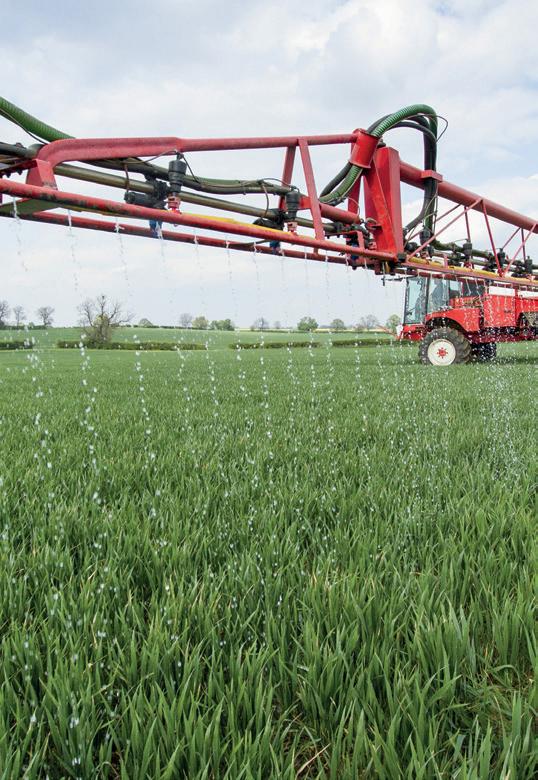


Demonstration plots of winter and spring crop varieties are progressing well at this year’s Cereals site on the Thoresby Estate in Nottinghamshire.
“Temperatures have been warmer, at around 14 degrees celsius, and not too much rain, which has been good for spraying,” says Mark Herriman, of Sencrop, which provided the weather stations.

The crop plots have a full suite of weather stations collecting data on rain, wind and sunshine – so rather than relying on information from a single source or a forecasting app, there is a full range of information specific to the trial plots.
Netting to protect winter oilseed rape from birds over winter has been removed following flowering, says Will Davies, farm consultant at Ceres Rural, who is overseeing the plots.
“The plots are starting to stand up tallthe oilseed rape has received a Plant Growth Regulator (PGR) and fungicide and will be in flower shortly. Monitoring for pollen beetle is ongoing,” says Mr Davies.
The winter sown crops – winter wheat,
Rust pressure was reported to be low, but some overwintered Septoria was present.

Crops certainly weren’t short of moisture through the winter,”says Mr Herriman.
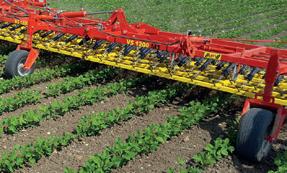
“Since the oilseed rape was planted it’s had 535ml of rain, which is interesting because we had 71ml in March and a very dry February.
Looking towards the spring crops, much of these were drilled in good conditions, and
“These have all had their fertiliser where required, and the February-drilled plots are up in-row and will now progress quickly in the milder weather,” says Mr Davies.
Overall, the crops are progressing well. “The rain is starting to ease off, giving the ground a chance to dry out – hopefully we will get some nice spring weather with enough rain to promote growth,” says Mr Herriman.
Last month saw the drilling of the final few crop plots, but much of April was given over to final fertiliser applications and getting herbicides, PGRs and fungicides applied at the appropriate timings for the different crop types.
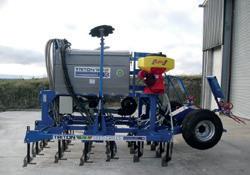

AGRICULTURAL
CORNERSTONE CORNERSTONE SYSTEMS LTD LTD




The CROPSENSE system has been completely redesigned with user interaction, remote accessibility and intelligent power efficiency at the heart of the design.
The CROPSENSE system has been completely redesigned with user interaction, remote accessibility and intelligent power efficiency at the heart of the design.



Designed and built in the UK, Cornerstone Systems offers the full package using our own engineers. From design and build, through to installation and long-term servicing of your CropSense systems. We even offer customisation of systems to meet your specific requirements.
Designed and built in the UK, Cornerstone Systems offers the full package using our own engineers. From design and build, through to installation and long-term servicing of your CropSense systems. We even offer customisation of systems to meet your specific requirements.

Key Features and Benefits:
Key Features and Benefits:
� Robust Design and Manufacture
� Secure, Full System Remote Accessibility
� Robust Design and Manufacture





� Automated Email and Texts
� Secure, Full System Remote Accessibility


� Battery Backup
� Automated Email and Texts


� Full Turnkey Solution
� Battery Backup



� Intelligent Control for Power Efficiency
� In-House Customisable System Software
� Full Turnkey Solution


� Integral Monitoring, Control and Data Storage
� Intelligent Control for Power Efficiency




� In-House Customisable System Software




CORNERSTONE CORNERSTONE SYSTEMS SYSTEMS LTD LTD Call now for your free





Call now for your free on-site demonstration 01785 818020

www.cornerstonesystems.co.uk
� Integral Monitoring, Control and Data Storage

www.cornerstonesystems.co.uk

Portable Bunded Tanks

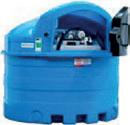
Steel Bunded Tanks

High Volume Water
U K is a leading supplier of Tanks and Liquid Handling Systems across Agriculture and, Construction, Industrial and Domestic.







Supported by a wide selection of pumps, fittings and accessories, we tailor systems to meet each customer’s requirements on request.
We provide free technical support, friendly advice and unrivalled service levels.









Sewage Treatment

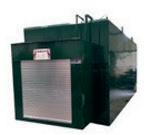

Fuel and AdBlue Bowsers
Tues 13th & Wed 14th June | New Venue: Thoresby Estate, Nottinghamshire, UK
Water Bowsers









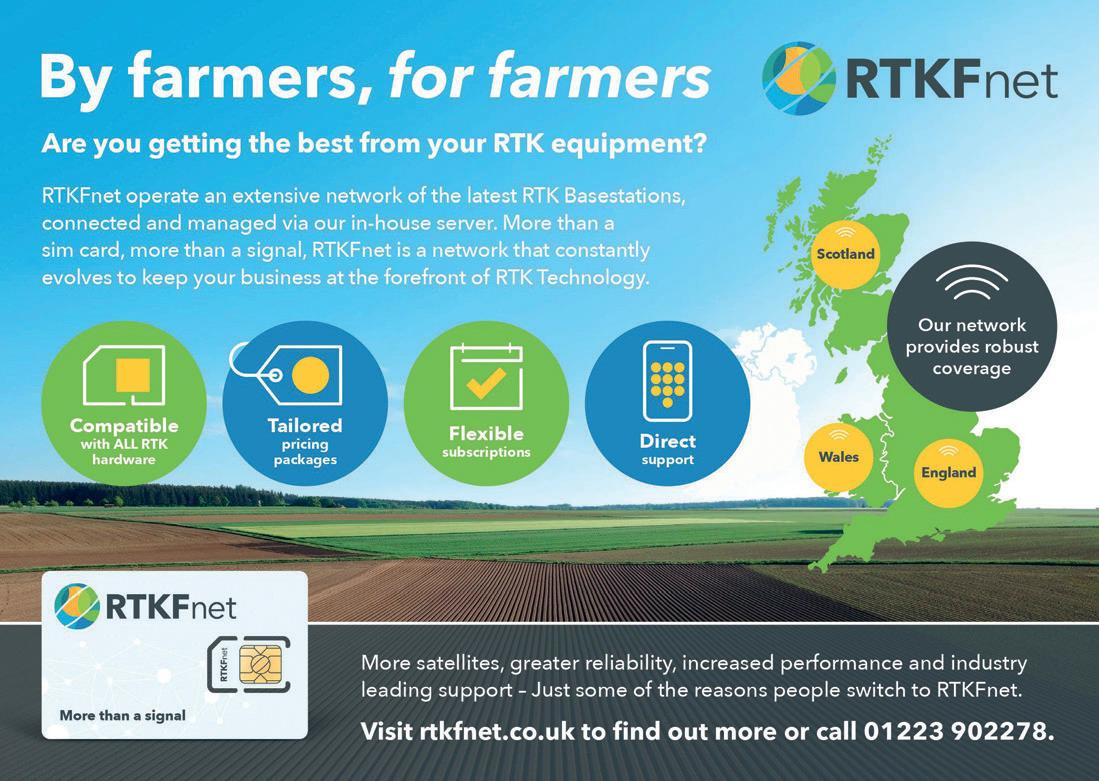
Anew law paves the way for the faster breeding and development of high-yielding, more nutritious and climate-resilient UK arable crops, say scientists.
The Genetic Technology (Precision Breeding) Act became law earlier this spring. It covers precision-bred plants and animals developed through techniques such as gene editing – creating beneficial traits that would take decades using traditional breeding.
The act sets in motion changes to allow farmers to grow crops which are drought and disease resistant, reduce fertiliser and pesticide usage, and breed animals that are protected from harmful diseases.
NIAB chief executive Mario Caccamo said the new law took gene editing out of the scope of restrictive rules applied to genetically modified organisms. In doing so, it paved the way for a more straightforward route to market for innovative plant varieties, he added.
Gene-editing has already helped develop wheat with improved food safety, oilseeds with enriched Omega-3 oils and barley with potential to improve livestock productivity while reducing greenhouse gas emissions.
ing offers significant opportunities to support healthier, safer and more sustainable farming and food production systems, at a time when such advances are urgently and increasingly needed.”
Although the new law represents a significant milestone, it is not the end of the process. For gene-editing to deliver, Prof Cacccamo said secondary legislation in the coming months must not go above and beyond rules currently applied to conventionally bred plant varieties.
World leader
The government said the new law would helping to make England a world-leader in agri-food innovation. Defra minister Mark Spencer said a new regulatory system would now facilitate greater research and innovation in precision breeding.
tastic news for British consumers and farmers. Precision breeding technologies are the future of food production not just at home but around the world – and this [law] will put our nation at the forefront of this revolution.”
Some 40% of crops globally are lost every year to floods, pests and other events.
Defra chief scientist Gideon Henderson suggested the new law would help support resilient UK food production for decades to come.
“This is an important time for agricultural science,” he said.
“The ability to use gene editing to make precise, targeted changes to the genetic code of organisms, in a way that can mimic traditional breeding, enables development of new crop varieties that are more resistant to pests, healthier to eat, and more resilient to drought and heat.
Tobacco plants have been engineered to manufacture an alluring perfume of insect sex pheromones – which could reduce the need for pesticides.
Researchers at the Earlham Institute in Norwich used precision gene engineering techniques to turn tobacco plants into solar-powered factories for moth sex pheromones. These pheromones mimic the signals of female insects, trapping or distracting
males from finding a mate.
Nicola Patron, who led the research and heads the Earlham Institute’s synthetic biology group, said creating genetic modules with the instructions to build new molecules could turn a plant such as tobacco into a “factory” that needed only sunlight and water to thrive.
“Synthetic biology can allow us to engineer plants to make a lot more of something

they already produce, or we can provide the genetic instructions that allow them to build new biological molecules, such as medicines or these pheromones.”
The Earlham team hope their work will pave the way to routinely use plants to produce a wide range of natural products.
Dr Patron said this process could be much cheaper than building complex molecules using chemical processes.
-
used gene editing to develop crops with beneficial traits
Gene editing offers significant opportunities
he government’s shift towards paying farmers and land managers for environmental goods and services means understanding farm biodiversity is more important than ever — especially if businesses are to be as profitable as possible.
Biodiversity refers to all forms of animal and plant life, both farmed and wild, and ranges from different crop varieties to birds, pollinators and pests. And good biodiversity is vital to productive agricultural systems.
Having a variety of different species and organisms on farmland helps to maintain soil fertility, contributing to pest and disease control and helpsing to pollinate crops.
There are also economic gains to be achieved from working to increase biodiversity.
As part of government support through the Sustainable Farming Initiative and Countryside Stewardship schemes, selecting options that reduce artificial herbicide use in favour of natural weed control can save input costs as well as preserve the health of beneficial insects.
Meanwhile, regenerative agricultural practices, such as reduced tillage, can help cut fuel costs and prevent the loss of organisms in the soil, which can benefit future crop health, productivity, and long-term profitability.
Outside the farm gate, there are also developing markets that could offer opportunities to generate income from farm biodiversity. Similar to carbon credits, commercial and private biodiversity schemes could enable farmers to diversify their existing arable operations in future.
Understanding potential
So what is the best way for farmers and land managers to measure, monitor – and ultimately profit – from their land’s biodiversity?
The first step is to create a baseline to establish a starting point for a farm or estate business. Carrying out a natural capital assessment will help iden-


tify the quality and quantity of any natural assets across a landscape and give a framework that future management decisions can be built on.
There are tools, such as Natural England’s Biodiversity Metric 4.0, that provide the basis for estimating the number of credits a parcel of land can produce but this also requires information on the habitats size, condition, connectivity and location.
There are other tools, such as Fera’s Land360, that use the latest satellite imagery to build a clear picture of the different aspects of natural capital within a farm’s boundary, including fields, margins, hedgerows, woodland and water features.
Remote sensing technology can be used to analyse the quantity and quality of the natural capital available and define habitat parcels — distinct areas of land that contain different features for plants and wildlife.

This process can be complex, so enlisting the support of remote sensing experts can be invaluable in ensuring you capture and interpret data accurately.
Ultimately, there is no one-sizefits-all solution for enhancing farm biodiversity, but by having a detailed, precise baseline, growers can consider the financial trade-offs when making decisions about their crops and land management practices.
It’s only when you fully understand the extent and quality of existing biodiversity on a farm that you can explore opportunities to improve it, and potentially reap the financial rewards associated with it.
Glyn Jones is head of plant science at Fera Science. See www.fera.co.uk
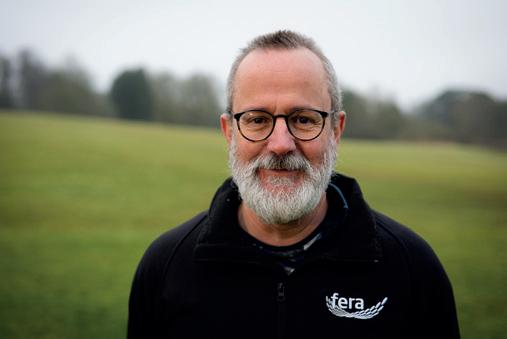
first step is to create a baseline
Fera’s Land360 is a tiered service that offers different approaches to measuring and monitoring natural capital.
The Mapping+ package combines the latest software, remote sensing tools and scientific expertise to set a baseline for farmers.
The comprehensive service involves producing an accurate digitisation of farmland using satellite imagery.


The Land360 Scoring+ package goes further to understand the quality of the natural capital of the landscape. Scoring+ takes the Mapping+ information and assesses the quality of this
Wildlife and biodiversity can generate economic benefits
natural capital to give farmers a clearer picture of the assets they have on the farm.
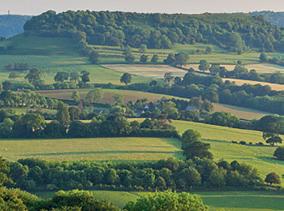
Land360 uses scientific ecological and biodiversity scoring to help build a strong picture of the quality of natural capital.
The final tier, Ecosystem+, sees scientists combine the collected Land360 data with farm management records to identify bespoke opportunities for future revenue streams.
Understanding the extent and quality of environmental assets on a farm sets a benchmark and forms a vital foundation for exploring opportunities to improve natural capital.
Improving farm biodiversity can be a valuable revenue source, Glyn Jones.
The

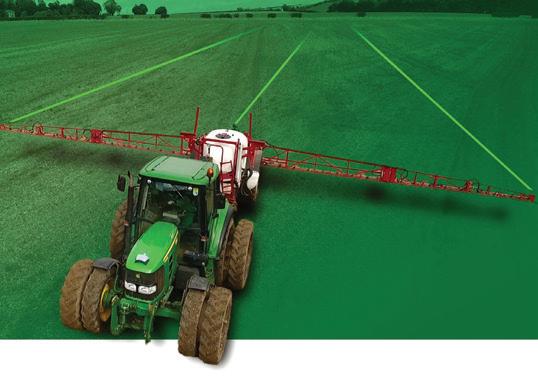

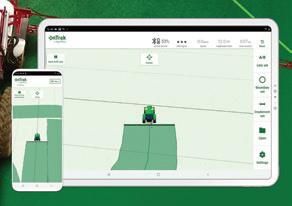









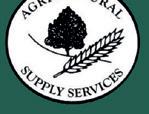




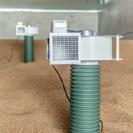

Anew sensor claims to help arable and vegetable growers manage their irrigation, fieldwork and disease protection more precisely.

Sencrop says its new Solarcrop irradiance sensor will help farmers curb costs and boost their productivity. It says the user-friendly low-cost system operates with large reach and exceptional accuracy.
As well as accurate weather forecasting, producers can link real-time solar irradiation, rainfall, humidity, temperature and wind data in one simple app, says Sencrop co-founder Martin Ducroquet.
Based on crop type and growth stage, this data is used to predict evapo-transpiration rates and soil moisture availability – helping farmers identify when and how much to irrigate without needing expensive localised soil probes.
“Much of the UK is getting drier –and more extreme weather events are
becoming the norm,” said Mr Ducroque. “In addition, the environmental issue around irrigation is no longer in question; producers can massively reduce their water consumption by optimising irrigation systems.
One sensor can monitor up to 10 fields across 10 miles. Based on two years of research and development and patented technology, Solarcrop is said to measure solar irradiation to an accuracy of 2%.

Combined with Sencrop’s Raincrop and Windcrop sensors – and individual field and crop information – soil moisture surplus or deficit can be accurately forecast for the coming seven days, enabling producers to better plan irrigation and field work.
Sencrop has a network of more than 2,000 connected weather stations across the country.
These stations generate ultraprecise and hyper local information like temperature, humidity, wind speed and rainfall.
John Deere has integrated its new G5 CommandCenter display into all 6, 7, 8 and 9 series machines ready for the 2024 model year.
The new G5 Plus CommandCenter includes documentation, data sync, JDLinkTM connectivity, variable rate application, section control and AutoTracTM guidance as standard on all six-cylinder 6R, 7, 8 and 9 series tractors.
Improved design
The G5 Plus CommandCenter was designed to provide a consistent user experience. It does so by providing full-screen viewing of more modules, shortcut keys and precision agriculture capabilities.
Operators can expect an easier setup and increased operator confidence

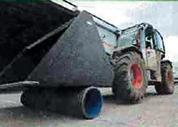
thanks to a customisable interface. John Deere says an improved design provides a better operating experience and maximises uptime.
Features include includes AutoTrac, section control, data synchronisation, documentation, overthe-air updates and remote display access. Users can easily switch between languages with the option to set active and alternate languages.
The 12.8-inch screen is 33% larger than the previous display, comes with 1080P high definition and a faster processor. The update is said to ensure the highest levels of precision agriculture efficiency, ease of use and operator comfort.
On the 6R machine, a redesigned steering column and new steering wheel provides the next level in comfort, especially on the road. A new

The company says the ability to measure solar irradiation maximises farmers’ ability to manage climatic risks, as well as diseases and pests – including blight and cercospora, so growers and agronomists can act on highly tailored risk-based advice.




Low-cost

The low-cost plug-and-play service means everyone can use it, not just



those with deep pockets, says Mr Ducroquet. The sensors are extremely quick and easy to install – and farmers can choose the appropriate subscription package for them.

Combined with accurate weather forecasts and real-time monitoring, farmers can optimise their use of inputs – for example only spraying and undertaking fieldwork when weather conditions are right, claims Mr Ducroquet.
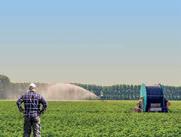

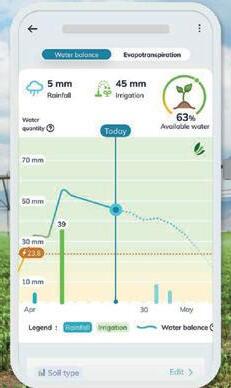



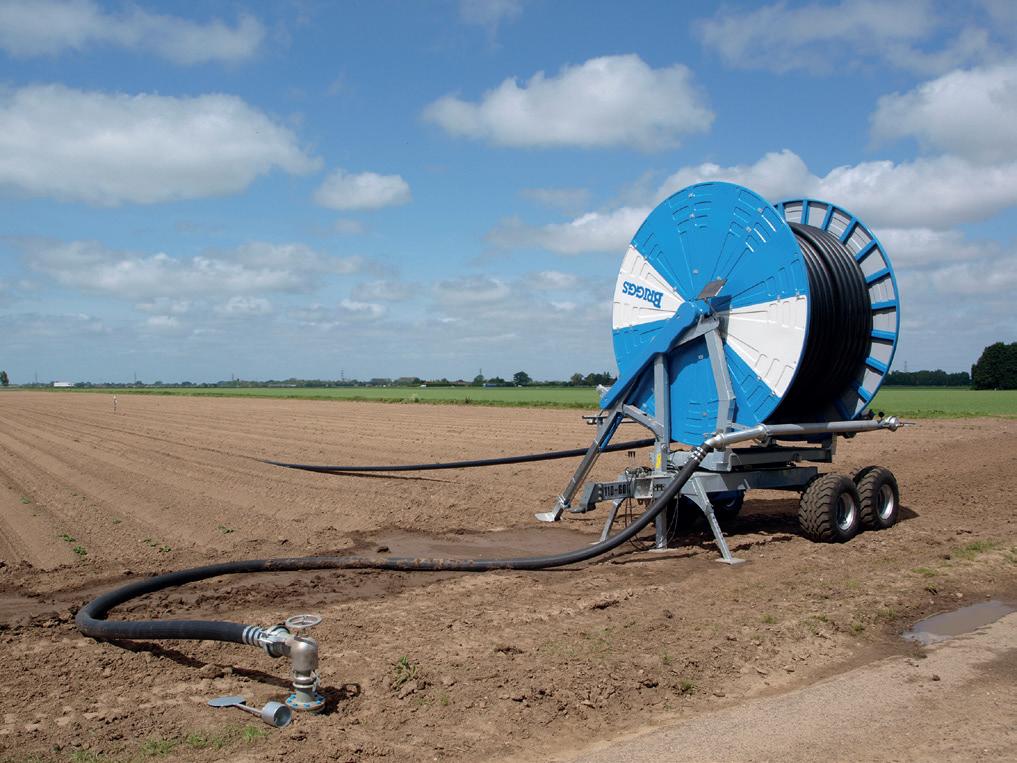
new steering system with a 50% increase in steering capacity. This is made possible by larger steering cylinders, which are fitted as standard to all 7R machines.
To enhance operator comfort during transport, the 7R features a new
active steering, the feature can be easily activated via a softkey.





Two additional front brake discs enhance transport performance. All 7, 8 and 9 tractors have a new highresolution corner post display and a built-in StarFireTM 7000.
More public and private investment is needed for livestock farmers to reach net zero, the government has been told.
The warning follows a raft of government announcements on green finance, net zero and energy security. The National Sheep Association said the plans were welcome but fell short and failed to specify the investment needed for agriculture.
The anouncements set out how the government plans to enhance the UK’s energy security, seize the economic opportunities of low carbon transition and deliver the government’s net zero commitment by 2050.
Defra ministers have pledged to maintain funding at £2.4bn for farming and the environment for the duration of the current parliament. But the department estimates that agriculture still accounts for 11% of total UK greenhouse gas emissions.
Welcoming the government’s commitment to develop a consistent approach for measuring emissions, NSA chief executive Phil Stocker said it was likely private money would have to bolster public funds for farming to reach net zero targets.
“While other industries have seen high levels of investment, Defra pol icies are currently inadequate to ena ble targets to be met, and new future farming schemes are not being ade quately measured and evaluated in terms of their contribution to net zero.
“Defra is being widely blamed for a lack of investment in policies that lead us to net zero and as a result agriculture is lagging behind improvements being made in some other industries such as the energy sector where moves towards renewables are clear to see.”
The government’s strategy outlines a Defra target of securing £1bn of private funding for nature recovery by 2030. And it pledges to work with the British Standards Institute to develop clear rules for farmers to access private payments for nature provision.
Mr Stocker said the existing £2.4bn budget provided some comfort – but was inadequate if a true value was placed on the public goods already delivered by agriculture, let alone meeting future climate, nature and natural resource challenges.
Huge untapped potential on UK farms could help deliver net zero – but the National Sheep Association says change is needed for farmers to take full advantage of the government's green finance strategy.

Farmers can already generate an income from sequestering carbon, looking after water and providing for nature. But NSA chief executive Phil Stocker says more changes are needed to planning, taxation and tenancy rules – as well as good advice.

“Farmers are rightly nervous of getting involved due to being uncertain about brokering the deal, the
actual values being offered, and whether they will need this themselves to offset their own farming activities in the future.
“There is little point in selling carbon credits today and in a few years’ time finding we have to offset our footprints by buying from others, potentially at a higher cost.
“We urgently need the government and Defra to implement the frameworks that allow this to happen so that farmers can spread income opportunities across food production and delivery of public goods and services.”
“We absolutely should expect future governments to not just continue this investment into our industry but to increase the budget based on the challenges ahead.
“While agriculture needs to reduce emissions, we also need agreed methods to take account of the entire carbon cycle including the role of sequestration in soils, grassland, and farm habitats such as hedgerows.
“The more we can reduce emissions the more offsetting sequestration opportunities arise to create income for the farm business, so to focus on both makes sense.
“We also need to make sure these private funding opportunities are made accessible for your average farmer not just for large operators or wildlife organisations who have the ability to produce a glossy prospectus.”
Changes are needed to the green finance strategy
Sheep producers would benefit from clearer help and guidance
Defra policies are currently inadequate
“

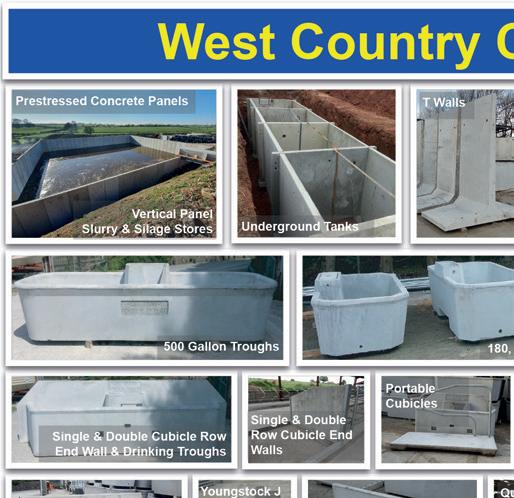
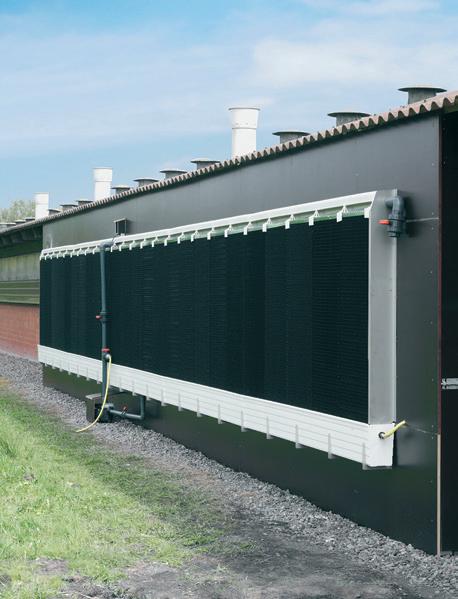
• The only pad cooling system featuring an innovative frame with one-piece top profile and pad retainer
• Snap-in pad retainers allow simple and quick pad replacement
• Easy installation, monitoring and maintenance


• Open design ensuring visible water flow
• No additional water tank required
Newquip Limited
NQ House | Conygarth Way | Leeming Bar Business Park
Leeming Bar | Northallerton | North Yorkshire DL7 9EE Tel. 01677 428600 | enquiries@newquip.co.uk www.newquip.co.uk | www.bigdutchman.com
Early detection of health problems in dairy cows could could lead up to a 15% reduction in the methane emissions they produce, according to new research.
The work was carried out by the Agricultural Research and Education Centre (AREC) Raumberg-Gumpenstein in Austria, in conjunction with dairy innovators, smaXtec. It looked at the impact of animal health on methane emissions.

Researchers found that smaXtec’s state-of-the-art bolus technology cah help farmers detect and treat sick cows sooner.

They say this could lead to a 1015% reduction in the amount of methane emissions per kg of milk produced.
Thomas Guggenberger, head of the Institute of Livestock Research at AREC RaumbergGumpenstein, says the calculation is based on IPCC standards to meas ure the benefits of smaXtec’s health monitoring system to improve ani mal health.
“Our calculations, which are also based on our own respiration experiments, have shown that animals with a longer useful life emit less methane per litre of milk at typical breed performance,” he adds.
“Early detection of disease and proactive health management can reduce animal losses, effectively reducing methane emissions in the dairy industry.”
director at smaXtec, says the findings correlate with a report called Acting on Methane by Ruminant Health & Welfare. It shows that better animal health can reduce greenhouse gas emissions by 10%.
He adds: “The smaXtec system has been proven to accurately detect diseases, such as mastitis, long before clinical symptoms appear.
“This study with AREC RaumbergGumpenstein shows that this not only leads to animals being treated quickly,
litre of milk they produce.”
Mr Howarth claims methane emissions from cattle are not comparable to emissions from fossil fuels because cow methane is converted back to carbon dioxide after about 12 years. However, despite this natural recycling process, reducing emissions will help farmers meet government targets.
“This study shows that our advanced system can lead to healthier cows and help farmers reduce the total methane emissions from their herds effectively and quickly – something that’s good for both the climate and wider dairy industry.”
Sheep farmers can make the most of funding from the Defra Animal Health & Welfare Pathway by optimising the timing of their worming treatment check.
Eligible livestock farmers can currently access £436 funding for a vet-led health and welfare review and a worming check, says the Sustainable Control of Parasites in Sheep (SCOPS) Group.
While the vet review should focus on issues most appropriate for an individual flock –whether lameness, fertility or other diseases – the worming check is designed specifically to determine the effectiveness of an anthelmintic treatment.
Independent sheep consultant Lesley Stubbings says: “The check is not a definitive test for anthelmintic resistance, but it does start you on a path to understanding which wormer groups are working effectively on your farm.
“By putting a little thought and preparatory work into when you carry out this test, you can make it a really useful start to understanding how to make the most of any worming treatments.”
Eligible farmers have just six months from the point of registration to complete the worming check.
But it should only be carried out on lambs that need to be treated because their worm burden is high enough.
Ideally, this means carrying out a faecal egg count (FEC) before starting the worming check to ensure timing is optimal.
“You cannot check the effectiveness of a treatment at killing adult worms if there are not enough worms present in the first place.”
The check consists of two egg counts. One is taken at treatment time to assess the adult roundworms present in the lambs. A second check is taken 7-14 days after treatment.
The difference determines how effective the treatment has been at killing the worms in the sheep.
Participating farmers will receive a sampling kit, instructions explaining how to take good samples and packaging with pre-paid postage back to the laboratory.
This will help farmers meet government targets
MOBILE FEED MILLING AND MIXING SERVICES FOR ALL BREEDS OF ANIMALS AND POULTRY





WE PROVIDE MOBILE FEED MILLING AND MIXING SERVICES FOR ALL BREEDS OF ANIMALS AND POULTRY, FROM STRAIGHT ROLLED CEREALS OR HAMMERMILLED PULSES TO COMPLETE MIXED RATIONS AND FEED BIN TRANSFERS.
With numerous suction and discharge options including directly into feed bins or separate bunkers, we are able to provide an efficient, traceable and consistently high standard of service for our customers.



Based in the West Midlands we run a fleet of modern ‘Tropper’ machines specifically built for precise mixing and accurate weighing operated by our experienced, friendly drivers.
To discuss your farm’s requirements please give us a call on:
James - 07584 582 598
Glyn on 07976 548766 / 01568 750 183
E: info@glynhamermillmix.co.uk





W: www.glynhamermillmix.co.uk
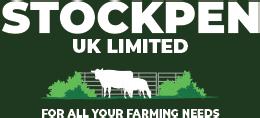
The Royal Three Counties Show, one of the UK’s largest and most esteemed agricultural events celebrating the countryside and rural life, returns to Three Counties Showground from 16-18 June 2023 with an outstanding agricultural programme.
As one of England’s biggest livestock and equine shows, more than 6,000 animals will feature, with the crowning of cattle, sheep, goat and pig champions across 900 classes, over 50 rare and minority breeds (the UK's largest collection) and 15 national breed shows.
Well-known rural TV presenter and rare and minority breeds farmer, Adam Henson, will return as show ambassador to inspire visitors in the Farming Village, while the Future of Farming Zone will welcome returning Clarkson’s Farm funnyman, author and cider connoisseur, Kaleb Cooper, on Saturday 17 June.


Tickets are on sale now, costing just £23 in advance and children under 16 are free of charge. To see the full programme and book tickets visit www. royalthreecounties.co.uk or call 01684 584 924.

• Bio oil fired heaters
• Oil and gas fired cabinet heaters

• Suspended oil and gas fired unit heaters

• Portable and mobile heaters


• Electric heaters
MAIN OFFICE: 02476 357960
SALES CONTACTS: Andy Wallis 07850 988382






andy@thermobile.co.uk | John Hall 07775 635527 john@thermobile.co.uk WEB: www.thermobile.co.uk


Adairy farmer has called on the government to make it easier for farmers to use cow slurry as a renewable energy source.

Norfolk milk producer Stephen Temple wants the government to tap into biogas, saying it is a major unused energy source. His own anaerobic digester has been turning slurry into energy for a number of years.
The AD plant uses slurry from the farm’s dairy herd, plus maize, low quality silage and whey from the onfarm cheese-making business. About 25% of the energy generated is used on the own farm with the rest exportsed to the national grid.
Like other farmers who supply milk to dairy company Arla, Mr Temple views the untapped potential of biogas as a potential way to help end the UK energy crisis. Arla says the plan could also support the UK’s energy independence.
Clean energy
Mr Temple said: “Cow slurry has the potential to power communities across the UK and be used as a natural fertiliser to nourish the land we farm. Unfortunately installation of an anaerobic digestor to make this happen is not cheap.
“We’re hoping that with the government’s help we can resolve the difficulties farmers face with grid connections, costly installations, and
regulatory and planning issues so we can better utilise this invaluable en ergy source.”
Last month, Arla helped erect a rep lica Victorian sewer lamp near Parlia ment Square to draw attention to the untapped potential of biogas as a re newable energy source derived from livestock slurry and food waste.
It came after the government an nounced a major new strategy to deliv er energy security and net zero. Arla said slurry was an often overlooked source of clean energy – and a new plan could harness its potential to power UK homes and businesses.
Biogas was once a staple of Victori an Britain after Birmingham engi neer Joseph Edmund Webb patented a sewer gas destructor lamp fuelled by emissions from London’s sewers. Arla said farm and food waste could do the same job.
It wants a new national anaerobic digestion strategy incorporating larg er community-based facilities gener ating biogases that can be fed into the gas grid. It is also championing better grid connections to help more farmers install AD plants.
Arla vice president James Pirie said: “Dairy farmers have the potential to play a major role in the future of the UK’s energy security, using natural resources to provide more energy
Biogas could power thousands of homes, says Stephen Temple
independence.”
Mr Pirie said Britain’s livestock sector had the potential to turn nearly 91 million tonnes of manure and slurry and 10 million tonnes of food waste into 8 billion cubic metres of biomethane – enough to power 6.4 million homes.
Landlords who applied for exemption from Minimum Energy Efficiency Standards for let residential property in 2018 are reminded that their exemption expires this year.
Landlords needed an Energy Performance Certificate (EPC) of at least Grade E to let out residential property – unless they were eligible to register for a valid exemption which allowed them to continue to rent the property out.
Alexander Macfarlane, head of building consultancy at Strutt & Parker, said: “Any
exemptions on the PRS Register last for five years, so this means there will now be property owners who have exemptions that have expired or will shortly do so.
“The rules state that at the end of the initial five-year period the landlord either needs to have made improvements to raise the EPC banding to an acceptable level, or they must apply for another exemption.”
Properties found on many rural estates
and farms can be challenging to raise to the required standards without risking damaging the fabric of the building. This meant many rural property landlords registered for an exemption.
Mr Macfarlane said: “Landlords need to be aware when reapplying they cannot rely on the fact that they had an exemption before.
“The purpose of the exemption is to afford a landlord time to make necessary improvements, rather than act as a mechanism for avoiding making improvements.”
Tractor maker CNH Industrial says taking a majority stake in methane energy company Bennamann will help it develop alternative fuels for agriculture.
CNH announced the stakeholding in Bennamann earlier this spring. The two companies have worked together for a number of years to capture and store methane emissions for energy – aiming to deliver a carbon negative fuel system for farming.
“By consolidating our share in Bennamann, we are offering our customers a full energy production, storage and distribution service,” explained CNH Industrial agriculture president Derek Neilson.
“This solution can transform farms into mini-energy hubs that can satisfy their own energy needs, produce their own natural fertiliser and sell any excess gas on the open market. It also enables them to generate their own electricity.
“This makes us a true alternative energy enabler, able to serve myriad applications and contribute to a carbon negative future.”
Reducing emissions such as methane and CO2 from biowaste and operations is one of agriculture’s greatest environmental challenges. But alternative fuels can enhance a farm’s productivity while offsetting its carbon footprint.
To help farmers meet this challenge, CNH has been pioneering sustainable
alternative energy sources for agriculture for more than two decades, including the first tractor running on compressed natural gas – the New Holland T6 180 Methane Power.

The tractor maker’s relationship with Bennamann began in 2019 when the two firms jointly developed a liquefied natural gas fuel tank for a prototype machine. CNH then acquired a minority stake in the business.
On a pilot farm in Cornwall, the shared technologies are capturing fugitive emissions from farm biowaste –specifically livestock slurry.
The gas is then purified into biomethane that is subsequently either compressed or liquefied.
Both types of biomethane can be used as vehicle fuel, to generate electricity, and even supply household or
CNH and Bennamann say the system they have developed provides energy independence from fossil fuels for the Cornish farm. It has reduced input costs – and could also generate an additional revenue stream.
This work has also led to the introduction of the world’s first liquefied fugitive methane tractor prototype, the New Holland T7 Methane Power LNG, which is operationally carbon negative when fueled by Bennamann’s system.
CNH says investing in Bennamann furthers the tractor maker’s commitment to lower CO2 emissions in agriculture. A 120-cow farm using methane capture technology can reduce the CO2 equivalent of 100 European households – about 780 tonnes annually.
It says it has now progressed beyond the prototype phase and will install the CNH Industrial-Bennamann solution on multiple farms over the next year. This will start with compressed fugitive methane solutions, moving to liquefied in the future.
Supermarket chain Waitrose believes methane-power could improve the sustainability of its flagship Leckford Estate farm in Hampshire.
The retailer has pledged that its UK farm supplier network will be net zero by 2035. And it is using its Leckford farm as a testbed to identify the best techniques to help achieve this goal across the industry.
This includes trialling the use of biomethane to power tractors, investing in a biomethane facility to harvest “fugitive methane” currently going into the atmosphere from ani-
mal manures and food processing by-products.
Waitrose suggests this new facility could save the equivalent of 500 tonnes of carbon emissions annually from going into the atmosphere. The biomethane captured will be converted into an eco-friendly fuel alternative to power vehicles.
Other initiatives include using hydrogenated vegetable oil to power food processing and farming activities. Waitrose is also working with the Small Robot Company to “drive innovation” in the low-emission autonomous machinery sector.
This solution can transform farms
“Above: The New Holland T7 methane powered Bennamann tractor at Trenance Farm, Cornwall


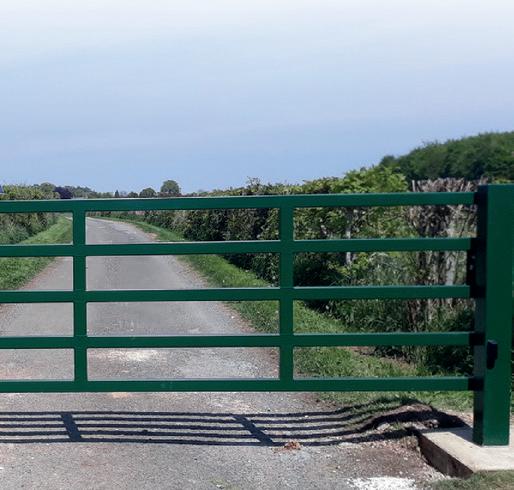



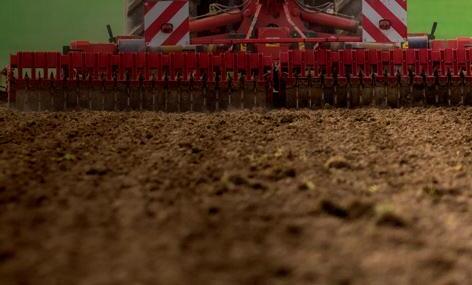
I asked a group of farmers recently and got mixed reactions The usual responses of “you can’t farm by numbers”, but also some quiet nods

Farm data is a powerful tool that can help farmers significantly improve their operations in a variety of ways Could farm data be the latest input used by farms?

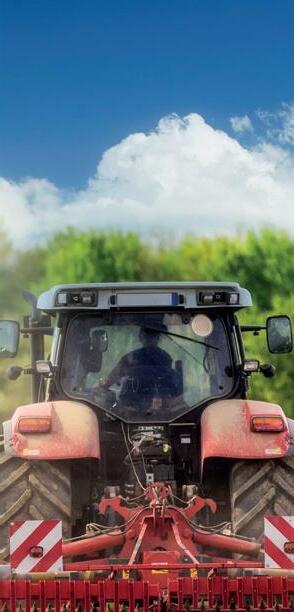

With the right systems and detailed analysis, the returns can be close to that of a decent NP&K application
One of the most significant benefits of using farm data is improved yields With last harvests’ grain prices, having an extra tonne per hectare to sell makes a huge difference to the bottom line The average spread of yield within a farming operation is around 40% Meaning with an average yield of 8 tonne, one field will yield 4 8 and another 11 2
Working with a farm this season, their yield was higher than average, but their spread of yields achieved was far wider The analysis showed that a contributing factor to the wider yield spread was an extended drill window of 6 weeks for winter wheat By narrowing that to 2 weeks they could achieve a far tighter range of yield, also reducing the risk of adverse weather whilst maintaining a higher overall output Financially, the data showed it was viable to invest in a second-hand drill and still see an increased net margin.
As we see input cost inflation, any efficiencies that can be found to optimise inputs are worth exploring Working with another farm, we analysed their chemical pricing versus the wider market They were purchasing their chemical at a decent price and using a fair split of R&D vs generic brands Digging into the detail, their application rates were on average 16% higher than similar farming operations achieving similar yields
With farms on average spending £200/ha on chemistry, that’s £32/ha efficiency to explore Continuing with the farm, we unearthed several factors leading to their higher rate - but paramount was a desire for a low-risk crop However, with the financial data revealing the cost of this approach, they adjusted for this season, aiming for a far lower cost of production

Evidently, farm data is a valuable resource that can help farmers make more informed decisions and improve their operations. Is it as valuable as fertiliser? I think that may depend on the farm However, the benefits of using farm data are clear From improving yields to optimising inputs and reducing costs, the potential returns of using farm data are substantial
Ross Dawson Customer Success Manager 07496 416032 rd@yagro comExperts say four recommendations could encourage more farmers to adopt practices that are good for their businesses as well as for the environment.
The independent farming, finance, and agrifood strategic working group was commissioned by Defra to find ways that will accelerate private investment as more farmers transition to low-emission and nature positive production methods.
A number of barriers mean the private sector is reluctant to invest in the switch to a greener future, says the group's Financing a Farming Transition report. Those barriers include lack of data and low confidence.
The report sets out four recommendations to overcome these challenges (see panel). It says adopting these measures could rapidly unlock private sector finance – encouraging food production and environmental improvements while diversifying farm incomes.
Farmers need greater financial support to deliver a resilient and secure food system while meeting the UK’s

Banks are exploring the potential for discounted loans to farmers who meet environmental outcomes –helping to cover the cost of the transition. Lenders are looking to support natural capital projects, with some banks keen to supply measurement and monitoring tools.
Supermarkets and food manufacturers are exploring premium payments for farmers who measure and reduce greenhouse gas emissions.
Buyers of ecosystem services are seeking to pay farmers for carbon improvements, habitat creation and flood risk reduction.
ambitious environmental goals – including the creation and restoration of at least 500,000ha of wildlife habitat, says the document.
Hertfordshire farmer and former NFU deputy president Stuart Roberts, who co-chairs the working group, said the environmental benefits provided by growers and livestock producers were becoming more important.

“We are seeing a change that we believe will, in time, place these environmental outputs on an almost equal financial footing with the other farming products.”
Mr Roberts said this opportunity could only be unlocked through transparency in standards, data, monitoring and reporting.
“Delivery of multiple outcomes has the potential to enable an exciting future for UK agriculture – but only if farmers, financiers, supply chain partners and politicians work together to embrace the opportunities.”
The report says unlocking sources of private finance to accelerate the farming transition is critical for food, environmental and economic security –as well as for reaching the UK’s net zero goals.
Additional sources of finance are central to diversifying farmers’ revenue streams, it says. They will incen-
increase food production while de-
Although the agriculture sec-

tor currently accounts for 11% of the UK's greenhouse gas emissions, lack of action could see this proportion increase to 30% by 2030 as other sectors reduce emissions more quickly.
Targets have also been set for 60% of England’s soils to be sustainably managed by 2030, with a 40% reduction of nitrogen, phosphorus and sediment pollution from agriculture into the water environment by 2038.
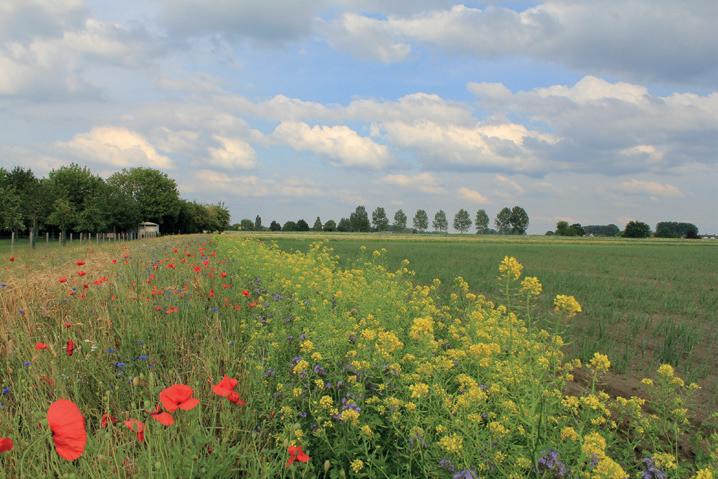
Defra minister Lord Benyon (below left) said the government would continue to work with farmers and other partners across the private sector to support investment in nature-friendly and productive farm businesses.


Better and more accessible data – including free mapping software – would help farmers, banks and the private sector integrate natural capital improvements into businesses and decision-making processes.
A clear vision from the government – including outcomes for soiul, water and biodiversity – would help the private sector and farming community know where to invest their time and resources.
Greater clarity and formal guidance on high-integrity environmental markets – including standards and details on the tax treatment of ecosystem services – will provide confidence for investment.
Better support – including funding and a community of practice – will encourage landscape-scale environmental improvements and greater capacity for farmers to attract private finance.

Environmental benefits from farming are becoming more importantLord Benyon (below): Public and private partners


JOIN US AT BATH & WEST SHOWGROUND
21-22 SEPTEMBER 2023
BE A PART OF THE SHOW
SCAN THE QR-CODE TO FIND OUT MORE ABOUT EXHIBITING

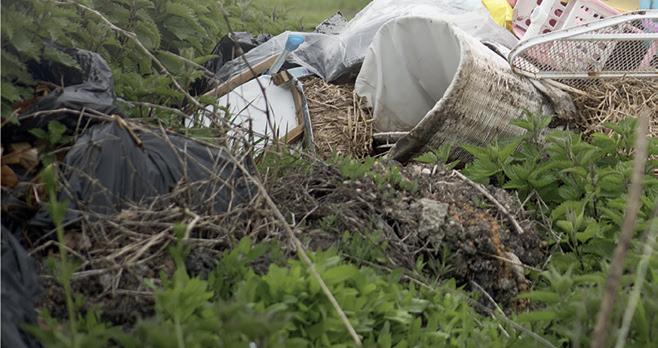


What is the difference between private land and public land? The answer, apparently, is about 12 inches.
Last month, a farming friend received a call from a near neighbour to tell him a lorry load of tyres had been dumped on his land. On closer inspection, he discovered alongside the tyres were several tree stumps.
A trail of mud on the road led my friend to a nearby farm that operates alongside a lorry and tyre business.
Of course, after contacting the police no physical evidence could be obtained and the matter could not be taken any further.

The culprits had managed to dump the waste half on the grass verge and half in the gateway of my friend's field – leaving him to bear the cost of clearing it away.
Now, I have known other farming associates who, when presented with the same problem, somehow manage to move any illegally dumped waste entirely onto the grass verge – making the clear-up a job for the local council.
That's understandable and easy to do –if a little naughty – when the waste in question is a fridge or an old mattress. But it is much harder when confronted with a lorry
load of tyres and half a forest. So my friend contacted the local council.
A person who can only be described as a jobsworth reluctantly agreed to visit the site. Eventually, having had a good look around, he told my friend that the tyres were on private land – despite a significant overlap.
The council employee insisted that the tyres were 12 inches away from the council’s property. My friend asked if the council could help. But he was swiftly told no – and the council employee couldn't recommend any firms that could either.
It seems that this local council – alongside many others – enjoys making life as difficult as possible for local businesses.
To make matters worse, the local council recycling centre has stopped accepting any sofas. The result is that nearby roadsides are rapidly becoming littered with lounge furniture of various shapes, sizes and colours.
On further investigation, my friend found two or three firms who said they would be willing to take the tyres. But their disposal would cost from £2000 upwards – and couldn't include any large lorry tyres.
Why not? Because the local council had imposed so many rules and regulations on the firm, making it difficult to dispose of large tyres properly and economically, so the company had to transportthem further afield.
Some organisations claim that fly-tipping incidents like this are on the decline. I'm not so sure. Farmers and landowners have simply stopped reporting incidents because nothing gets done. Instead, they are clearing away the waste themselves.
In this area, as soon as one pile of waste is cleaned up, the next pile appears. It doesn't matter whether gates are locked or gateways are blocked – the culprits dump their illegal rubbish anyway.
Even when caught, fines are seldom and punishment is ridiculously light. Unless the dumpers can be caught red-handed or filmed, the chance of prosecution is slight.
It is unacceptable that local councils refuse to clear waste from private land – especially as they make waste disposal so difficult with too many regulations and permits that are unworkable.
Once again, local farms and local rural residents suffer alongside the majority of the public. Like many others, my farming friend faces a bill for thousands of pounds and the dumpers are likely to return very soon.
Even when caught, fines are seldom “
